Welcome to TiCon REST API
0 Introduction
Here you will find all information to get started using TiCon4 REST API. We'll start with an example how to read time element data from TiCon and how to write data back to TiCon. These first two chapters will enable you to do standard work.
If you want to know more about the data structure and detailed concepts of the API you should continue reading all the following chapters. Have fun using our API.
1 Reading data from TiCon
1.1 Version information
This is the simplest call, that also does not require authorization, to get details about the TiCon REST API version.
{{ServerAddress}}/ticon-web/services/management/version
Returns
Details about current TiCon REST API version and used TiCon4 database version. If there is an error while connection to the database, the error message will appear here, a detailed message can be obtained from Azure insight or Windows Event viewer.
{
"serverTime": "2023-11-27T08:59:45Z",
"version": {
"apiVersion": "4.08.09.1977 [.NETCoreApp,Version=v6.0]",
"dbVersion": "TiCon408Praes [4.08.06.0007]"
}
}
1.2 Configuration information
This is the simplest call, that also does not require authorization, to get details about the TiCon REST API configuration.
{{ServerAddress}}/ticon-web/services/management/configuration
Returns
Details about current TiCon REST API configuration.
{
"serverTime": "2023-11-27T09:28:51Z",
"configuration": {
"sqlConnectionTimeout": "15",
"sqlCommandTimeoutInSeconds": "30",
"sqlConfiguration": [
{
"key": "DataSource",
"value": "(LocalDB)\\MSSQLLocalDB"
},
{
"key": "ApplicationName",
"value": "TiCon4"
},
{
"key": "InitialCatalog",
"value": "TiCon407"
},
{
"key": "AttachDBFilename",
"value": "C:\\ProgramData\\MTM\\TiCon 4.07\\db\\TiCon4.mdf"
}
]
}
}
Remarks
You can configure the SQL command timeout, if it is necessary, e.g. if you get a SQL Client timeout exception. Beware this parameter is not the SQL connection timeout value! Edit the SqlCommandTimeoutInSeconds option in the appsettings.json file, don't forget to restart your service, after you change the value.
1.3 Languages
This call needs also no authorization, to get information about all languages.
{{ServerAddress}}/ticon-web/services/management/languages
Returns
A list of all installed languages in the TiCon4 database. If you use the parameter lang, you can use one displayed language to get all texts in this specific language.
{
"serverTime": "2023-11-27T09:28:51Z",
"languages": [
{
"languageCode": "de",
"languageDescription": "Deutsch",
"countryCode": "DE",
"countryDescription": "Deutschland"
},
{
"languageCode": "en",
"languageDescription": "English",
"countryCode": "US",
"countryDescription": "United States"
}
]
}
1.4 Time elements
To retrieve basic data for Time Elements, also known as analyses, you can use the following call:
{{ServerAddress}}/ticon-web/services/data/time-elements?code={{code}}&lang=en-US&expand[description]&expand[times]&expand[elementType][description]&expand[elementStatus][description]&expand[structure][row][description]&expand[structure][row][element][times]&expand[structure][row][criterion][description]&expand[defaultcriterion][description]
The table below lists where to find the data numbered in the TiCon screenshot.
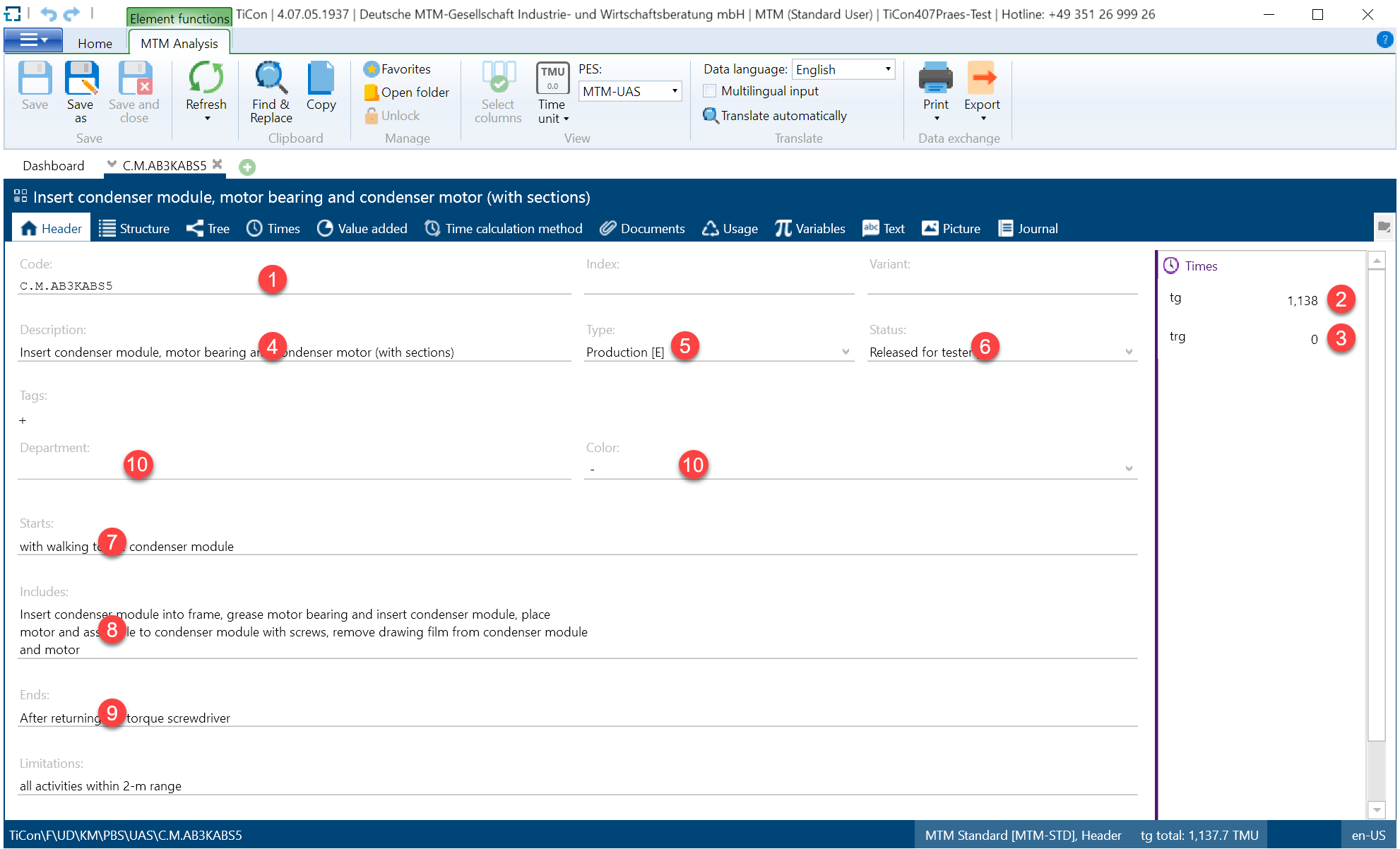
| No. | Content | Property Name and Remarks |
|---|---|---|
| 1 | Code of time element | entities[0].code |
| 2 | Basic time of element | entities[0].times.tg |
| 3 | Other times of element | entities[0].times.XXX |
| 4 | Description of element | entities[0].description.text |
| 5 | Type of element | Search for entities[0].elementTypeUid in expanded[] (expanded[x].uid = elementTypeUid), then read expanded[x].code and expanded[x].description.text |
| 6 | Status of element | Search for entities[0].elementStatusUid search in expanded[] (expanded[x].uid = elementStatusUid), then expanded[x].code and expanded[x].description.text |
| 7 | Starts | entities[0].begin.text |
| 8 | Includes | entities[0].content.text |
| 9 | Ends | entities[0].end.text |
| 10 | Criterions of element | entities[0].criteria[].row.elementCriterionUid element criteria structure row (expanded[x].elementCriterionCode and expanded[x].(textValue or numberValue)) |
Remarks
A Time element can have a short code, entities[0].shortcode, depending on the chosen analysis method.
All displayed times in TiCon4 REST API will be shown in TMU.
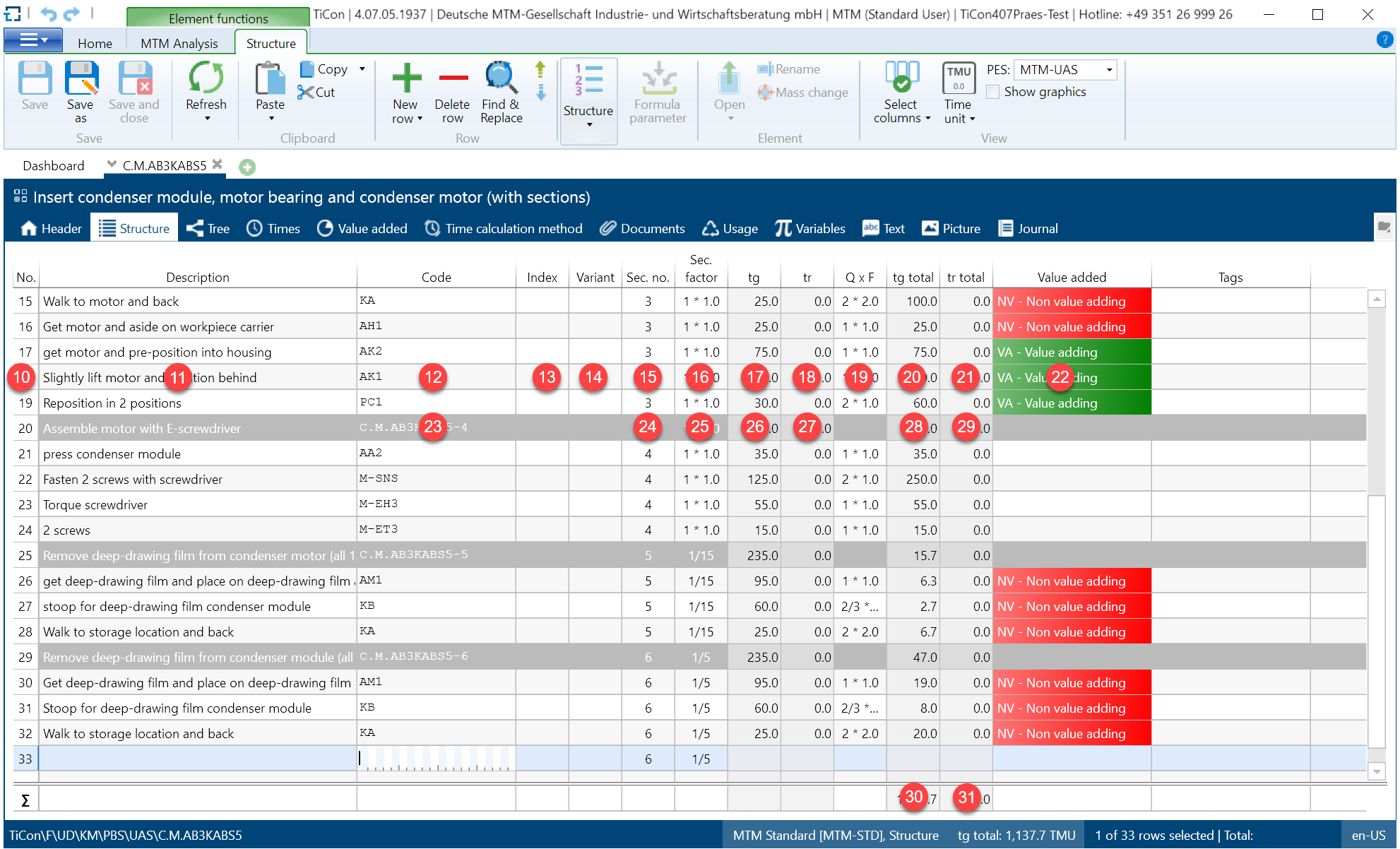
| No. | Content | Property Name and Remarks |
|---|---|---|
| 10 | Order number of structure row | entities[0].structure[].row.orderNumber |
| 11 | Description of usage | entities[0].structure[].row.description.text |
| 12 | Code of used element | Search for entities[0].structure[].row.elementUid in expanded[] (expanded[x].uid = structure[].row.elementUid), then read expanded[x].code |
| 13 | Index of used element | analogous to 12, then read expanded[x].index |
| 14 | Variant of used element | analogous to 12, then read expanded[x].variant |
| 15 | Section number | entities[0].structure[].row.sectionNumber |
| 16 | Section factor string | entities[0].structure[].row.sectionFactor |
| 17 | Basic time of used element | entities[0].structure[].row.times.tg |
| 18 | Setup time of used element | entities[0].structure[].row.times.tr |
| 19 | Factorstring of usage | use entities[0].structure[].row.factor for display (can be a formula) and entities[0].structure[].row.factorValue (is always a calculated number including the section factor and other factors) for calculations |
| 20 | Total basic time of used element | entities[0].structure[].row.totaltimes.tg |
| 21 | Total setup time of used element | entities[0}.structure[].row.totaltimes.tr |
| 22 | Indictors | Search for entities[0].structure[].row.criterionUids[0] in expanded (expanded[x].uid = structure[].row.criterionUids[0]), then read expanded[x].color for the color and expanded[x].code for the code |
| 23 | Code of sections | entities[0].code + "-" + entities[0].structure[].row.sectionNumber in expanded[] (expanded[x].uid = structure[].row.elementUid), then read expanded[x].code |
| 24 | Section number | entities[0].structure[].row.sectionNumber |
| 25 | Section factor string | entities[0].structure[].row.sectionFactor |
| 26 | Basic time of used elements in section | analogous to 17 |
| 27 | Setup time of used elements in section | analogous to 18 |
| 28 | Total basic time of section | analogous to 20 |
| 29 | Total setup time of section | analogous to 21 |
| 30 | Total basic time of whole structure | sum of all structure basic times |
| 31 | Total setup time of whole structure | sum of all structure setup times |
You will find three different types of lines: Section lines, Element lines and lines containing just a comment. These lines can be identified as follows:
- Element lines
structure[].row.rowType = "REFERENCE" and structure[].row.typeEnum = "Element" - Comment lines
structure[].row.rowType = "REFERENCE" and structure[].row.typeEnum = "Text" - Section lines
structure[].row.rowType = "SECTION_HEADER"
1.5 Detailed documentation
A detailed REST API documentation with description of data schema and possible query parameters can be found here.
1.6 Filtering
The TiCon REST API offers different ways to filter TiCon4 elements. The most common use case is searching by code, index and variant:
{{ServerAddress}}/ticon-web/services/data/time-elements?code={{code}}&index={{index}}&variant={{variant}}&lang=en-US&expand[description]
It is also possible to search TiCon4 elements by folder properties, like ID or path:
{{ServerAddress}}/ticon-web/services/data/time-elements?folderUids={{uid,uid}}&expand[description]&expand[folder][description]
{{ServerAddress}}/ticon-web/services/data/time-elements?folderpath={{path}}&expand[description]&expand[folder][description]
If you want to search recursive thru the folder path, add foldersrecursive=true to your parameters:
{{ServerAddress}}/ticon-web/services/data/time-elements?folderpath={{path}}&expand[description]&expand[folder][description]&foldersrecursive=true
It is not recommended to use folderUids and folderPath at the same time!
A most important use case is to search elements by their status. You can filter TiCon4 elements lower than a certain status lt, or by status greater than or equal, gte:
{{ServerAddress}}/ticon-web/services/data/time-elements?expand[elementstatus]&statuslt={{elementStatus}}
{{ServerAddress}}/ticon-web/services/data/time-elements?expand[elementstatus]&statusgle={{elementStatus}}
The next section shows more examples of how you can filter in the TiCon4 REST API.
{{ServerAddress}}/ticon-web/services/data/time-elements?expand[description]&expand[elementconfiguration]&ownercodes={{code}},{{code}}
{{ServerAddress}}/ticon-web/services/data/time-elements?expand[description]&expand[elementconfiguration]&owneruids={{uid}},{{uid}}
{{ServerAddress}}/ticon-web/services/data/time-elements?expand[description]&expand[elementconfiguration]&eccCodes={{code}},{{code}}
{{ServerAddress}}/ticon-web/services/data/time-elements?expand[description]&expand[elementconfiguration]&elementconfiguids={{uid}},{{uid}}
1.6.1 Joker characters
It is possible to use joker characters in filtering, e.g. as many or replace by one any character. Possible placeholders are
%,*Placeholders for many any characters_,?Placeholders for one any character
Joker characters only working, when *Wildcards parameter is set to true. At next some examples.
{{ServerAddress}}/ticon-web/services/data/time-elements?codeWildcards=true&code=3000K_.....5
{{ServerAddress}}/ticon-web/services/data/time-elements?codeWildcards=true&code=3000K*
{{ServerAddress}}/ticon-web/services/data/time-elements?codeWildcards=true&code=3000??.....5
1.7 Advanced search in TiCon REST API
The TiCon REST API offers an advanced search mechanism. To call the advanced searching, you have to use the following URL, it is necessary to create a search filter item as JSON in the request body and send it as POST to the server:
{{ServerAddress}}/ticon-web/services/data/search
{{ServerAddress}}/ticon-web/services/data/search?expand[times]&sortby=index,description desc
The default order behaviour of advanced search is Code, Index, Variant, but you can change this by set sortby keyword. If you want sort your results by ModifyUser.Code, you have to set the query parameter dueDate, see exmaple.
{{ServerAddress}}/ticon-web/services/data/search?expand[times]&sortby=modifyuser.code,description desc&dueDate=2023-5-15
Caution: very complex filter configurations can cause connection timeouts!
Remarks
If the search JSON is not valid, the TiCon REST API throws an exception.
Each new row is a or nexus.
If you want to show standard times or the descriptions, use the expand parameter, see chapter _6.5
1.7.1 Different filter types
The TiCon REST API advanced search supports different filter types:
- MasterFilter
- TimeFilter
- TagFilter
- FolderFilter
- ElementCriteriaFilter
- CodeIndexVariantFilter
- IndicatorFilter
- EawsEvaluationFilter
- JournalFilter
- DescriptionFilter
- ElementTextsFilter
- ElementClassConfigurationFilter
- ElementTypeStatusFilter
- ShortCodeFilter
- DeletedFilter
- ReferenceFilter
Every filter type has his own configuration framework. At first you have to set the filterType property, afterward defining the rows property, which can be very complex.
The filter typs ElementTypStatusFilter, ShortCodeFilter and JournalFilter needs a special row, the searchpair row. This row is necessary for search pairs that are needed in the advanced search in TiCon4.
In the extended search you can use different value types, it depends on the filter type. The next table shows you what possibilities you have.
| String | Number | List | Date | Bool |
|---|---|---|---|---|
| Equals | Equals | Equals | Equals | Equals |
| Like | NotEquals | NotEquals | LessThan | NotEquals |
| Contains | LessThan | GreaterThan | ||
| NotContains | LessOrEquals | |||
| GreaterOrEquals |
Remarks
When you use the DeletedFilter no other filter type is possible, otherwise the TiCon REST API throws an exception.
1.7.1.1 MasterFilter
The behavior of the master filter is different from the other filter types. Only the stringValue and the language are allowed. In addition, there is a Property searchedField, which may have the following properties:
- MasterData - the string is searched in Code, Index, Variant and Description
- TimeData - the string is searched in Begin, Content, End and Limit of TimeElements and HWD-Elements
- All - is a combination of MasterData and TimeData
The compare operator is always contains, no other operators are valid. Wildcards are not allowed in this filter type and only one row is approved. The master filter can combined with the other filter types, please keep in mind, the logical operator between the other filter types and the master filter is always AND - (Code OR Index Or Variant OR Description) AND other filter type.
Examples:
[
{
"filterType": "masterfilter",
"rows": [
{
"stringValue": "aufnehmen",
"language": "de-DE",
"searchedFields": "MasterData"
}
]
}
]
or
[
{
"filterType": "masterfilter",
"rows": [
{
"stringValue": "leicht",
"language": "de-DE",
"searchedFields": "All"
}
]
},
{
"filterType": "codeindexvariantfilter",
"rows": [
{
"code": "3000AA",
"compareOperator": "contains"
}
]
}
]
The second example searches in Code OR Index OR Variant OR Description that contains the word leicht AND the Code contains 3000AA.
1.7.1.2 TimeFilter
In the TimeFilter the timeType and the numberValue are mandatory properties you have to set for filter to work. The timeType can have this options:
- TG
- TE
- TRG
- TR
Here a very simple example:
[
{
"filterType": "timefilter",
"rows": [
{
"timetype": "tg",
"compareoperator": "notequals",
"numbervalue": 83.333333
}
]
}
]
1.7.1.3 TagFilter
The TagFilter expect no compare operator, it is always Equals. Code or Uid is mandatory, when both properties are given, the Uid is taken. Here is an simple example:
[
{
"filterType": "tagFilter",
"rows": [
{
"code": "rd"
},
{
"code": "gr"
}
]
}
]
1.7.1.4 FolderFilter
The FolderFilter expect no compare operator, it is always Equals.
Uid or Path is mandatory, when both properties are given, the Uid is taken. Keep in mind, when you add Code, you will get an exception. If you use the path property, the string is handle as SQL like, e.g. 'UD\HG' becomes 'UD\HG%'.
Optional you can set IncludeSubFolders property, to search also in the subfolders. Here is an simple example:
[
{
"filterType": "folderFilter",
"rows": [
{
"path": "UD\\EAWS"
}
]
}
]
1.7.1.5 ElementCriteriaFilter
In the ElementCriteriaFilter the compare operator you can use, depends on the elementCriteriaType property, here the options you have for this property:
- String (
stringValueis mandatory) - List
- Date (
stringValueis mandatory, a valid date as string spelling) - Bool (
numberValueis optional, the value 0 or 1 is allowed) - Number (
numberValueis mandatory)
Code or Uid is mandatory, when both properties are given, the Uid is taken. If you use List as elementCriteriaType the property fixedCriterionValue is mandatory. Code or Uid is mandatory for this property. Here are some examples:
[
{
"filterType": "elementCriteriaFilter",
"rows": [
{
"code": "bool.crit",
"compareOperator": "equals",
"elementCriteriaType": "bool",
"numberValue": 0
}
]
}
]
[
{
"filterType": "elementCriteriaFilter",
"rows": [
{
"code": "date",
"compareOperator": "lessthan",
"elementCriteriaType": "date",
"stringValue": "2024-05-08"
}
]
}
]
[
{
"filterType": "elementCriteriaFilter",
"rows": [
{
"code": "color",
"compareOperator": "notequals",
"elementCriteriaType": "list",
"fixedcriterionvalue": {
"code": "r"
}
}
]
}
]
1.7.1.6 CodeIndexVariantFilter
The CodeIndexVariantFilter is a string value filter. Code or Index or Variant have to set or all properties together. Here a very simple example:
[
{
"filterType": "codeindexvariantfilter",
"rows": [
{
"code": "3000AA1....5",
"compareOperator": "equals"
}
]
}
]
1.7.1.7 IndicatorFilter
In the IndicatorFilter the properties IndicatorCriterion and Indicator are mandatory, Code or Uid is not optional, when both properties are given, the Uid is taken.
The IndicatorFilterType is depreciated and hence optional. If given, only the value Element is valid. To search for Indicators in the structure use the ReferenceFilter.
This filter finds all elements where the indicator is set in the element header. The IndicatorFilter is a List filter type, see table. Here is a example:
[
{
"filterType": "indicatorFilter",
"rows": [
{
"compareOperator": "equals",
"indicatorCriterion": {
"code": "nv"
},
"indicator": {
"code": "vaad"
}
}
]
}
]
1.7.1.8 EawsEvaluationFilter
The EawsEvaluation is a number value filter, see table. The properties eawsEvaluationFilterType and numberValue are mandatory. The eawsEvaluationFilterType can take this values:
- TotalScore
- WholeBodyScore
- PostureScore
- ForceScore
- LoadScore
- ExtraPointsScore
- UpperLimbsScore
- TotalFfg
- AwkwardPostureScore
- TotalFurtherFactorsScore
- TotalDurationScore
Here some very simple examples:
[
{
"filterType": "eawsEvaluationFilter",
"rows": [
{
"eawsevaluationfiltertype": "totalscore",
"compareoperator": "equals",
"numbervalue": 2
}
]
}
]
[
{
"filterType": "eawsEvaluationFilter",
"rows": [
{
"eawsevaluationfiltertype": "wholebodyscore",
"compareoperator": "greaterthan",
"numbervalue": 5
},
{
"eawsevaluationfiltertype": "totalDurationScore",
"compareoperator": "lessthan",
"numbervalue": 10
}
]
}
]
1.7.1.9 JournalFilter
The JournalFilter needs a searchpair row, because it needs two information to get the filter work, journalEntry and journalDate. When both properties are not set, the filter will be ignored.
The compare operators of journalEntry depends on the configured journalFilterType. The journalFilterType can take this values:
- None
- Owner
- Creator
- Changer
- ChangeCode
- ChangeReason
- ChangeType
If you use Owner, Creator or Changer the compare operators Equals or NotEquals are possible. Code or Uid is mandatory, when both properties are given, the Uid is taken. If you use ChangeCode or ChangeReason all compare operators of string are possible, see table. StringValue is mandatory. If you use ChangeType you have to use JournalChangeType property, that can take this values:
- None
- IsCodeChanged
- IsDescriptionChanged
- IsStructureChanged
- IsTimeChanged
- IsTimeIndirectChanged
- IsDocumentChanged
- IsElementStatusChanged
- IsAssignmentStructureChanged
- IsValidityChanged
- IsEvaluationChanged
- IsBasicChanged
If you use None all given values are ignored!
The journalDate is of type date, see table. This values are valid:
- None
- CreationDate
- ChangeDate
Here some very simple examples:
[
{
"filterType": "journalfilter",
"rows": [
{
"searchpair": {
"journalentry": {
"journalfiltertype": "creator",
"compareoperator": "equals",
"code": "mtm"
},
"journaldate": {
"journalfiltertype": "none"
}
}
}
]
}
]
[
{
"filterType": "journalfilter",
"rows": [
{
"searchpair": {
"journalentry": {
"journalfiltertype": "owner",
"compareoperator": "equals",
"code": "mtm"
},
"journaldate": {
"journalfiltertype": "changedate",
"stringvalue": "2021-01-01",
"compareoperator": "lessthan"
}
}
}
]
}
]
1.7.1.10 DescriptionFilter
The DescriptionFilter is of type string, see table. StringValue is mandatory, the property Language is optional, when not set, it filters the description by the current language of the RestAPI server. Here a very simple example:
[
{
"filterType": "descriptionfilter",
"rows": [
{
"description": {
"stringvalue": "aufnehmen",
"language": "de-DE",
"compareOperator": "notcontains"
}
}
]
}
]
1.7.1.11 ElementTextsFilter
The ElementTextsFilter is of type string, see table. You can set the following values
- begin
- end
- limit
- content
Each block consists of the properties StringValue, is always mandatory, and Language, is optional. Here a simple example:
[
{
"filterType": "elementtextsfilter",
"rows": [
{
"compareOperator": "contains",
"begin": {
"stringvalue": "schaufel ansetzen",
"language": "de-DE"
},
"end": {
"stringvalue": "teile ausgeschüttet",
"language": "de-DE"
}
}
]
}
]
1.7.1.12 ElementClassConfigurationFilter
The ElementClassConfigurationFilter expects only Code or Uid, when both properties are given, Uid is taken. The compare operator is optional and always Equals. Here a simple example:
[
{
"filterType": "elementClassConfigurationFilter",
"rows": [
{
"code": "T.ST2"
}
]
}
]
1.7.1.13 ElementTypeStatusFilter
The ElementTypeStatusFilter needs a searchpair row, because it needs two information to get the filter work, elementtype and elementstatus. When both properties are not set, the filter will be ignored. elementtype is of type list, see table, elementstatus is of type number, see table. The compare operators of both blocks are mandatory. Code or Uid of elementtype is optional, Code or Uid of elementstatus is mandatory.
Here some very simple examples:
[
{
"filterType": "elementtypestatusfilter",
"rows": [
{
"searchpair": {
"elementtype": {
"compareOperator": "equals"
},
"elementstatus": {
"code": "3",
"compareOperator": "equals"
}
}
}
]
}
]
[
{
"filterType": "elementtypestatusfilter",
"rows": [
{
"searchpair": {
"elementtype": {
"code": "p",
"compareOperator": "equals"
},
"elementstatus": {
"code": "3",
"compareOperator": "equals"
}
}
}
]
}
]
[
{
"filterType": "elementtypestatusfilter",
"rows": [
{
"searchpair": {
"elementtype": {
"code": "p",
"compareOperator": "equals"
},
"elementstatus": {
"code": "3",
"compareOperator": "equals"
}
}
},
{
"searchpair": {
"elementtype": {
"code": "e",
"compareOperator": "equals"
},
"elementstatus": {
"code": "7",
"compareOperator": "equals"
}
}
}
]
}
]
1.7.1.14 ShortCodeFilter
The ShortCodeFilter needs a searchpair row, because it needs two information to get the filter work, shortcode and analyzemethod. When both properties are not set, the filter will be ignored.
Shortcode is manadatory and of type string, see table. You must also set the Analyzemethod property. In this block Code or Uid is mandatory, when both properties are given, the Uid is taken. Analyzemethod is of type list, see table. Here is a simple example:
[
{
"filterType": "shortcodefilter",
"rows": [
{
"searchPair": {
"shortcode": "AHG02",
"compareOperator": "like",
"analyzeMethod": {
"compareOperator": "notequals",
"code": "mtm-1"
}
}
}
]
}
]
1.7.1.15 DeletedFilter
The DeleteFilter must set a deletedelement block. At first you have to set DeletedElementType property, this values are valid:
- Code (the compare operator is of type string)
- Index (the compare operator is of type string)
- Variant (the compare operator is of type string)
- FolderLabel (the compare operator is of type string)
- ElementClassConfigCode (the compare operator is of type string)
- AccountCode (the compare operator is of type string)
- DeletedAccountCode (the compare operator is of type string)
- ElementType (the compare operator is of type list)
- ElementStatus (the compare operator is of type list)
- Tg (the compare operator is of type number)
- Trg (the compare operator is of type number)
- Date (the compare operator is of type date)
If you want to search by Code, Index, Variant, FolderLabel, ElementClassConfigCode, AccountCode, DeletedAccountCode or Date the StringValue is mandatory. If you want to search by Tg or Trg the NumberValue is mandatory. You can only add one property per row!
Here some very simple examples:
[
{
"filterType": "deletedfilter",
"rows": [
{
"deletedelement": {
"deletedelementtype": "accountcode",
"compareoperator": "equals",
"stringvalue": "mtm"
}
}
]
}
]
[
{
"filterType": "deletedfilter",
"rows": [
{
"deletedelement": {
"deletedelementtype": "code",
"compareoperator": "notcontains",
"stringvalue": "k"
}
}
]
}
]
1.7.1.16 ReferenceFilter
The ReferenceFilter allows to search for properties of a structure row (row in short) of an element. The properties ReferenceType and ReferenceOperatorType must be set in any case. Depending on the value of ReferenceType there are more things to be aware of:
| ReferenceType | Operator | Value propert(ies) | Remarks |
|---|---|---|---|
| Count | Number | NumberValue | Total count of rows in the element. ReferenceOperatorType is not mandatory. |
| Description | String | StringValue, Language | Description of the row |
| Key | String | Code, Index, Variant | Code, Index, Variant of the row |
| Factor | String | StringValue | Factor of the row |
| Indicator | List | Indicator, IndicatorCriterion | Indicator of the row. See IndicatorFilter on how to fill the value properties. |
| Tag | List | Tag | Tag of the row. See TagFilter on how to fill the value property. |
For ReferenceOperatorType the following values are valid:
- AnyRow: An element is a hit if at least one structure row meets the filter criteria
- AllRows: An element is only a hit if all structure rows meet the filter criteria
- SameRow: Only valid from the second filter row onwards. Combines the filter of the row before with the current filter.
Here some examples:
[
{
"filterType": "referencefilter",
"rows": [
{
"referenceType": "count",
"numberValue": 10,
"compareoperator": "greaterThan",
}
]
}
]
[
{
"filterType": "referencefilter",
"rows": [
{
"referenceType": "description",
"stringValue": "leicht",
"language": "de-DE",
"compareoperator": "contains",
}
]
}
]
[
{
"filterType": "referencefilter",
"rows": [
{
"referenceType": "key",
"code": "3000",
"compareoperator": "contains",
}
]
}
]
[
{
"filterType": "referencefilter",
"rows": [
{
"referenceType": "factor",
"stringValue": "1 * 2",
"compareoperator": "contains",
}
]
}
]
[
{
"filterType": "referencefilter",
"rows": [
{
"referenceType": "indicator",
"referenceOperatorType": "allRows",
"compareOperator": "equals",
"indicatorCriterion": {
"code": "nv"
},
"indicator": {
"code": "vaad"
}
}
]
}
]
[
{
"filterType": "referencefilter",
"rows": [
{
"referenceType": "tag",
"compareOperator": "notEquals",
"code": "GR"
}
]
}
]
[
{
"filterType": "referencefilter",
"rows": [
{
"referenceType": "description",
"referenceOperatorType": "anyRow",
"stringValue": "leicht",
"language": "de-DE",
"compareoperator": "contains",
},
{
"referenceOperatorType": "sameRow",
"referenceType": "tag",
"compareOperator": "equals",
"code": "RD"
}
]
}
]
1.7.2 Examples
1.7.2.1 Search by code, index, variant
To search by code, index and variant with wildcards, your mask in TiCon looks like the screenshot shows.

The corresponding JSON for the TiCon REST API is very easy.
[
{
"filterType": "codeIndexVariantFilter",
"rows": [
{
"code": "2000A*",
"compareOperator": "Like"
}
]
}
]
When you add another row, your JSON looks as following:
[
{
"filterType": "codeIndexVariantFilter",
"rows": [
{
"code": "2000A*",
"compareOperator": "Like"
},
{
"code": "AN",
"index": "2",
"compareOperator": "Equals"
}
]
}
]
Every new row in the filter definition is an OR nexus. When you add a new filterType with rows, it is an AND nexus.
1.7.2.2 Search by code or index or variant and description
If you want a filter to search by code 2000A* OR index OR variant AND a description contains "walk", the TiCon search mask looks as follows:
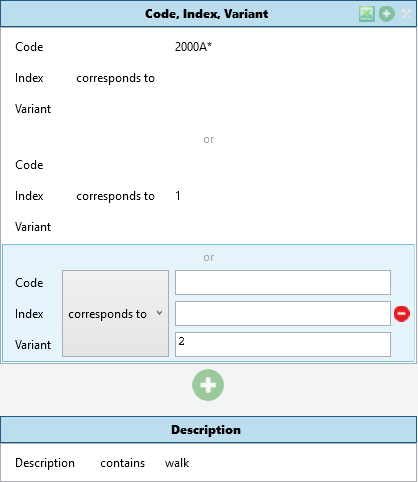
The TiCon REST API JSON is the following:
[
{
"filterType": "codeIndexVariantFilter",
"rows": [
{
"code": "2000A*",
"compareOperator": "Like"
},
{
"index": "1",
"compareOperator": "Like"
},
{
"variant": "2",
"compareOperator": "Like"
}
]
},
{
"filterType": "descriptionFilter",
"rows": [
{
"description": {
"stringValue": "walk",
"language": "en-US",
"compareOperator": "Contains"
}
}
]
}
]
1.7.2.3 Search by code or index or variant OR description
You can change the AND behavior in the upper example, by setting the andCompare property to false. To do that, add this keyword to the URL:
{{ServerAddress}}/ticon-web/services/data/search?expand[times]&sortby=modifyuser.code,description desc&dueDate=2023-5-15&andCompare=false
1.7.2.4 Search element type 'XY' in folder 'XX'
The next example looks like the screenshot below, it is a search by element type and folder.
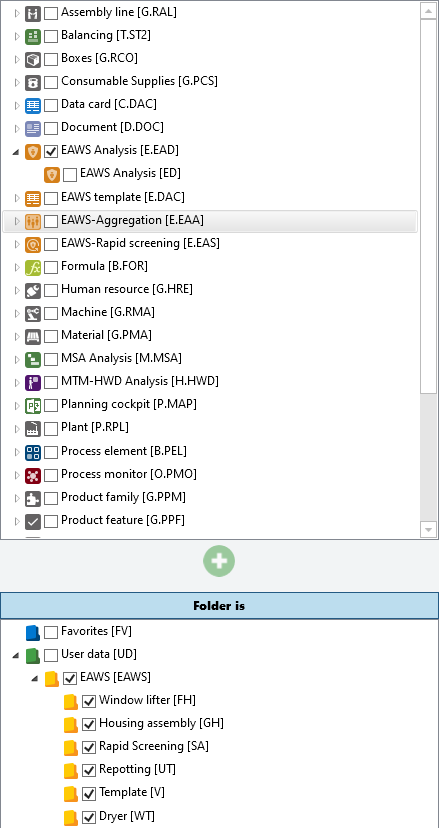
The user wants to search by an Element type of "E.EAD" in folders "EAWS", "FH", "GH", "SA", "UT", "V" and "WT". The following JSON definition is valid in this case.
[
{
"filterType": "elementClassConfigurationFilter",
"rows": [
{
"code": "e.ead"
}
]
},
{
"filterType": "folderFilter",
"rows": [
{
"uid": "Folder-25"
},
{
"uid": "Folder-26"
},
{
"path": "UD\\EAWS\\GH"
},
{
"uid": "Folder-30"
}
]
}
]
1.7.2.5 Search element type 'XY' in folder 'XX' and change date 'xxxx-xx-xx'
You create the following search mask in TiCon, the search parts are element type, folder and change information.
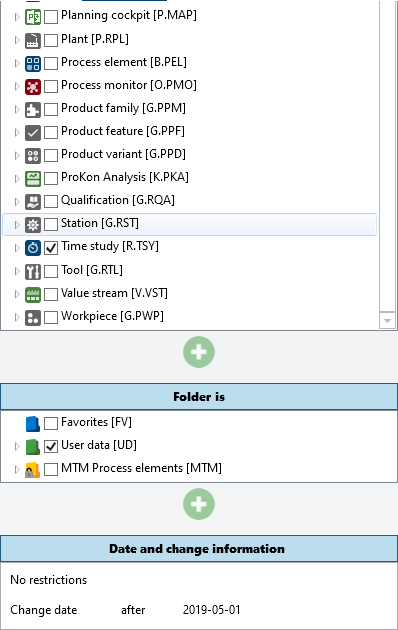
The JSON body for the TiCon REST API is a bit complex, let's take a look.
[
{
"filterType": "ElementClassConfigurationFilter",
"rows": [
{
"code": "R.TSY"
}
]
},
{
"filterType": "folderFilter",
"rows": [
{
"code": "UD"
}
]
},
{
"filterType": "journalFilter",
"rows": [
{
"searchPair": {
"journalEntry": {
"journalFilterType": "None"
},
"journalDate": {
"stringValue": "2019-4-22",
"compareOperator": "greaterThan",
"journalFilterType": "changeDate"
}
}
}
]
}
]
Remarks
The search filter journalFilter needs a row pair, called searchPair. Inside this clause you have to define a journalEntry and a journalDate property. As you can see, you have to set the journalFilterType, here is a list of all possibilities.
- None
- Owner
- Creator
- Changer
- CreationDate
- ChangeDate
- ChangeCode
- ChangeReason
1.7.2.6 Search for elements in folder 'XY' with element criterion 'X'
In TiCon you have to create the following search mask, take a look at the screenshot.
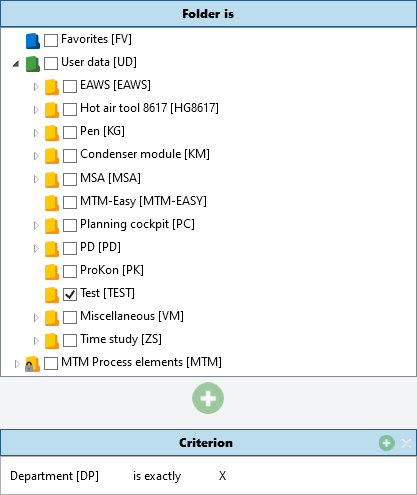
We will search for elements in folder "TEST" where the criterion Department is exactly "X". The TiCon REST API JSON is as following:
[
{
"filterType": "folderFilter",
"rows": [
{
"path": "UD\\TEST"
}
]
},
{
"filterType": "elementCriteriaFilter",
"rows": [
{
"code": "dp",
"compareOperator": "Equals",
"elementCriteriaType": "String",
"stringValue": "X"
}
]
}
]
Remarks
The elementCriteriaFilter needs an elementCriteriaType, because in the critias some different types exist.
- String
- Number
- Date
- List
- Bool
When the elementCriteriaType is a list value, the JSON looks like this.
{
"filterType": "elementCriteriaFilter",
"rows": [
{
"code": "GD",
"compareOperator": "NotEquals",
"elementCriteriaType": "List",
"fixedCriterionValue": {
"code": "m"
}
}
]
}
When you set a DateTime value, be careful, that it is in a valid writing form. The schema is always year-month-day hour:minute:second (yyyy-MM-dd hh:mm:ss), independently from locale language settings. All times are in GMT. Take a look:
{
"filterType": "elementCriteriaFilter",
"rows": [
{
"code": "DATE",
"compareOperator": "LessThan",
"elementCriteriaType": "Date",
"stringValue": "2023-4-9"
}
]
}
2 Writing data to TiCon
As TiCon supports multilingualism, writing data to TiCon creates text in all installed languages (installed in TiCon that is) with the leading language being the login language. So be sure to add the leading/login language via the lang query parameter (i.e. {{ServerAddress}}/ticon-web/services/data/time-elements?lang=en-US) or via header (first value in Accept-Language) to each call.
Otherwise the language (culture) of the servers OS is the leading/login language. This can lead to unforeseen errors i.e. when the servers culture is not installed in TiCon.
2.1 Time elements
The next chapter will describe how to create a new Time element with the TiCon4 REST API. To create a new element, you have to create a JSON structure in the request body and send it as a POST request. Following properties are mandatory:
- Code
- folderUid
- elementConfigurationUid
To create a new Time element with the TiCon4 REST API you have to call the following URL:
{{ServerAddress}}/ticon-web/services/data/time-elements
2.1.1 Simple example
At first a very simple example, to create a Time element with code and a certain element class configuration, the user needs the minimum permission write.
[
{
"code": "AN.1...3",
"folderUid": "Folder-130",
"elementConfigurationUid": "ElementClassConfiguration-100013"
}
]
The table below lists where to find the data numbered in the TiCon screenshot.
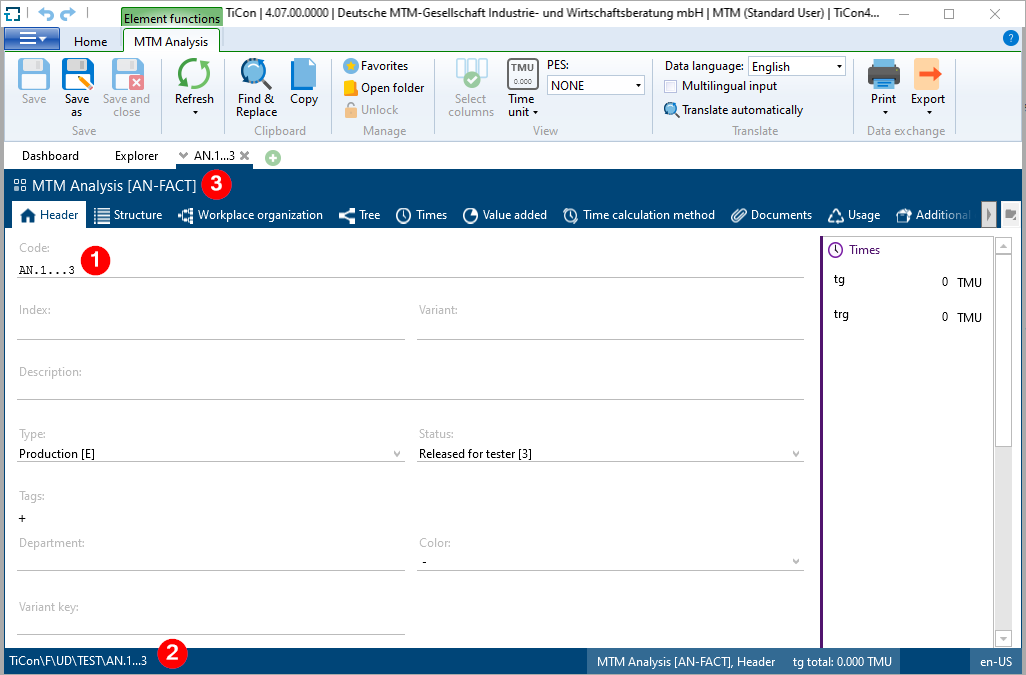
| No. | Content | Property Name and Remarks |
|---|---|---|
| 1 | Code of time element | entity.code |
| 2 | Folder to save the element | entity.folderUid you need a folder, you have the permission write, to get folders see chapter 6.6.3 |
| 3 | Element class configuration of element | entity.elementConfigurationUid you need the Uid of the element class configuration, see chapter 6.6.4 |
2.1.2 Text handle example
Here an example to create a Time element with code, description, begin, content, end and limit, this shows you how to handle text fields in the TiCon4 REST API:
[
{
"code": "AN.1...3",
"folderUid": "Folder-130",
"ownerUid": "Account-2",
"elementConfigurationUid": "ElementClassConfiguration-100013",
"description": {
"language": "en-US",
"text": "Insert condenser module, motor bearing and condenser motor"
},
"begin": {
"language": "en-US",
"text": "with walking to condenser module"
},
"end": {
"language": "en-US",
"text": "After returning torque screwdriver"
},
"limit": {
"language": "en-US",
"text": "all activities within 2-m range"
},
"content": {
"language": "en-US",
"text": "Insert condenser module into frame, grease motor bearing and insert condenser module..."
}
}
]
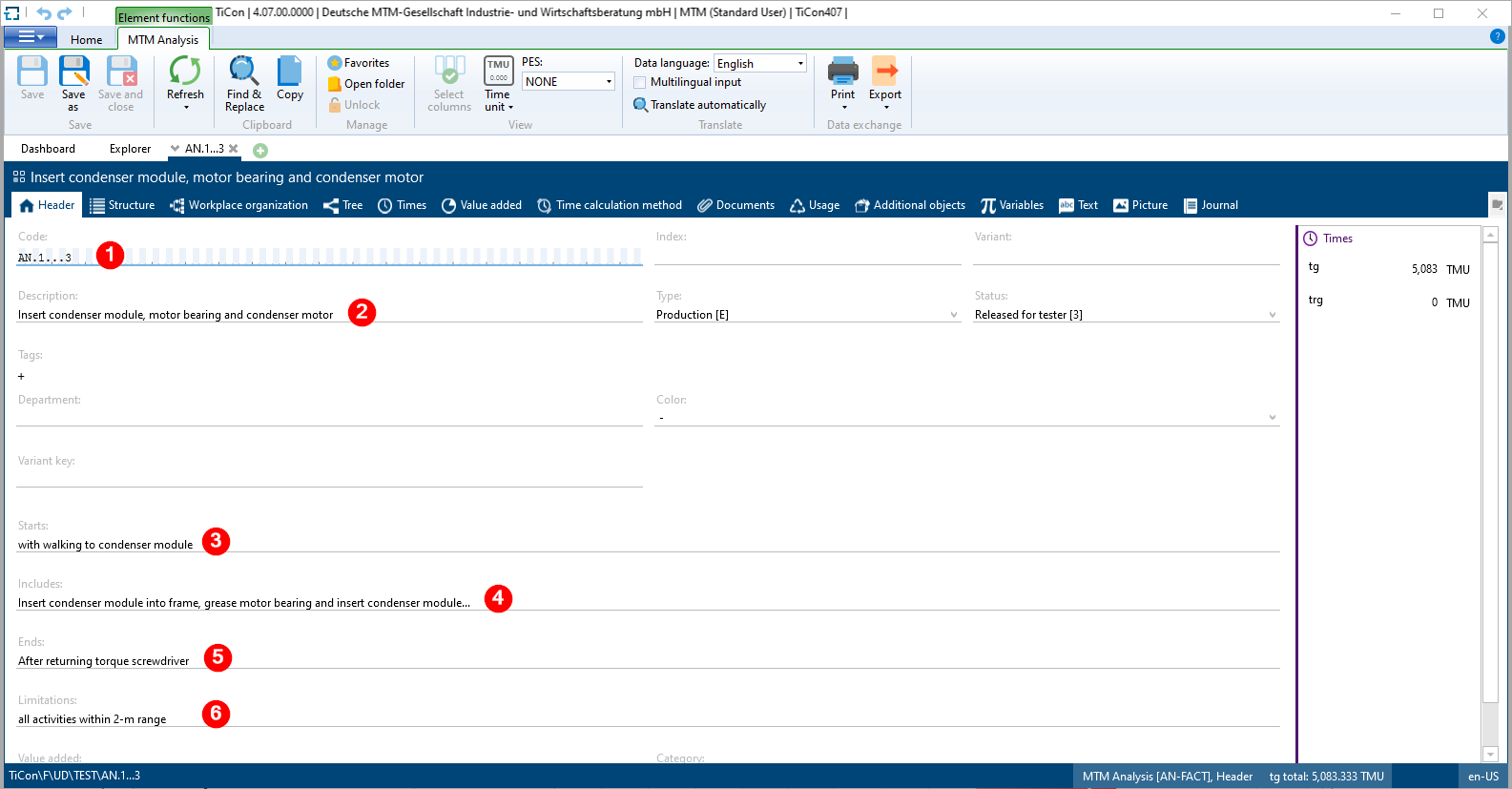
| No. | Content | Property Name and Remarks |
|---|---|---|
| 1 | Code of time element | entity.code |
| 2 | Description of element | entity.description.text |
| 3 | Starts of element | entity.begin.text |
| 4 | Includes of element | entity.content.text |
| 5 | Ends of element | entity.end.text |
| 6 | Limitations of element | entity.limit.text |
Remarks
When you work with text fields, remember to add the language property!
2.1.3 Full example
Here a full example, that includes a very simple structure.
[
{
"code": "AN.1...3",
"folderUid": "Folder-130",
"ownerUid": "Account-2",
"elementConfigurationUid": "ElementClassConfiguration-100013",
"description": {
"language": "en-US",
"text": "Insert condenser module, motor bearing and condenser motor",
"isSource": true
},
"begin": {
"language": "en-US",
"text": "with walking to condenser module",
"isSource": true
},
"end": {
"language": "en-US",
"text": "After returning torque screwdriver",
"isSource": true
},
"limit": {
"language": "en-US",
"text": "all activities within 2-m range"
},
"content": {
"language": "en-US",
"text": "Insert condenser module into frame, grease motor bearing and insert condenser module..."
},
"times": {
"ttbUser": 3416.6666666666665,
"ttu": 3416.6666666666665,
"ttuUser": 2500.6666666666665,
"tg": 3416.6666666666665,
"te": 3416.6666666666665,
"t": 3416.6666666666665
},
"elementStatusUid": "ElementStatus-7",
"elementTypeUid": "ElementType-1",
"workorganizationType": "None",
"structure": [
{
"row": {
"elementUid": "Element-1005",
"factor": "2",
"ordernumber": 1,
"typeEnum": "Element",
"description": {
"language": "en-US",
"text": "Walk to motor and back"
}
}
},
{
"row": {
"elementUid": "Element-1005",
"factor": "1",
"ordernumber": 2,
"typeEnum": "Element",
"description": {
"language": "en-US",
"text": "2 screws"
},
"criterionUids": [
{
"key": "1",
"value": "IndicatorCriterion-10003"
}
]
}
},
{
"row": {
"elementUid": "Element-1004",
"factor": "3",
"ordernumber": 3,
"typeEnum": "Element",
"description": {
"language": "en-US",
"text": "Torque screwdriver"
},
"criterionUids": [
{
"key": "1",
"value": "IndicatorCriterion-10004"
}
]
}
},
{
"row": {
"elementUid": "Element-13605",
"factor": "1.5",
"ordernumber": 4,
"typeEnum": "Element",
"description": {
"language": "en-US",
"text": "stoop for deep-drawing film condenser module"
},
"criterionUids": [
{
"key": "1",
"value": "IndicatorCriterion-10004"
}
]
}
}
]
}
]
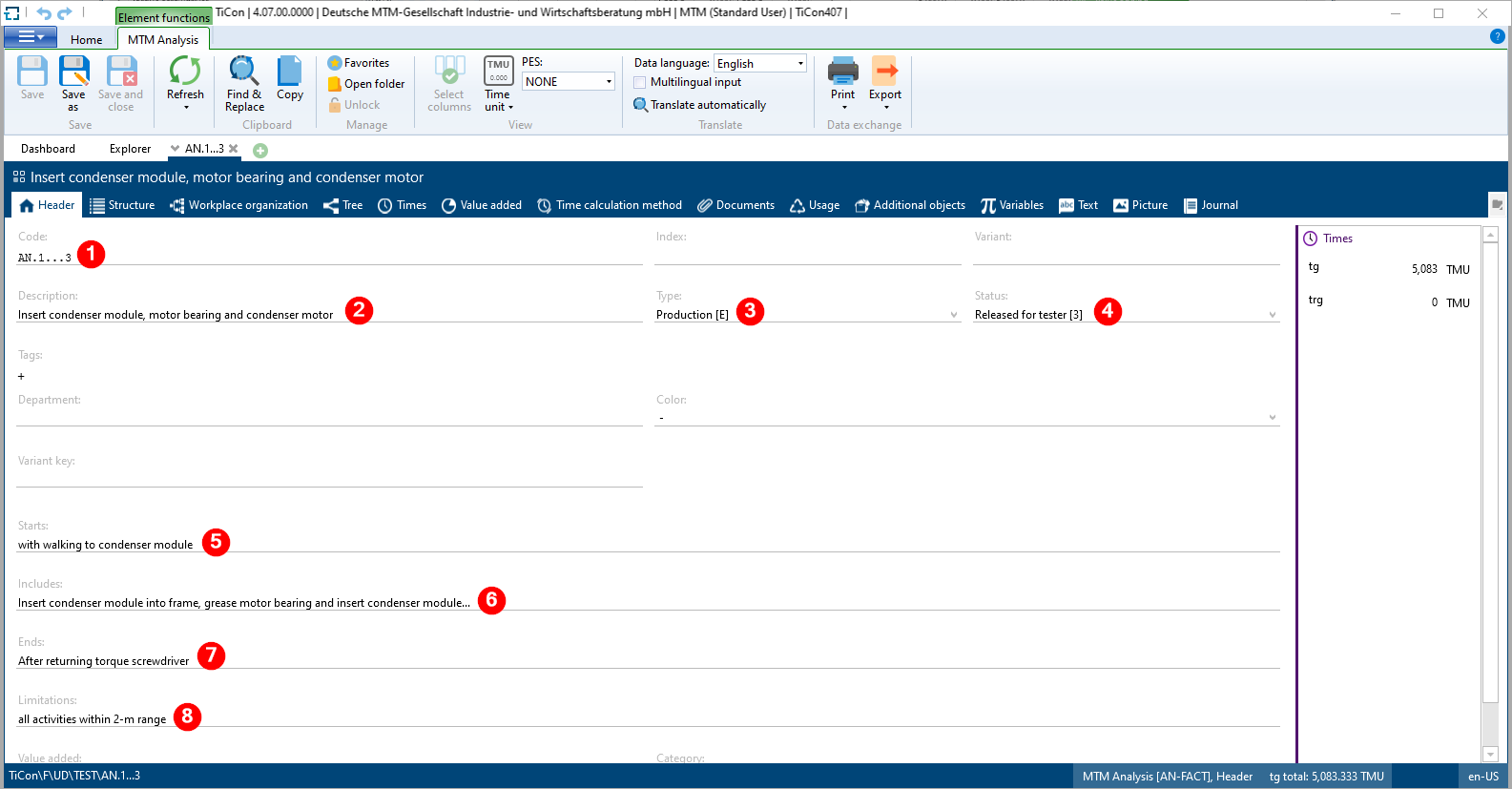
| No. | Content | Property Name and Remarks |
|---|---|---|
| 1 | Code of time element | entity.code |
| 2 | Description of element | entity.description.text |
| 3 | Type of element | entity.elementTypeUid you need the Uid of element type, which Uids are possible, see chapter 6.6.5 |
| 4 | Status of element | entity.elementStatusUid you need the Uid of element status, which Uids are possible, see chapter 6.6.6 |
| 5 | Starts of element | entity.begin.text |
| 6 | Includes of element | entity.content.text |
| 7 | Ends of element | entity.end.text |
| 8 | Limitations of element | entity.limit.text |
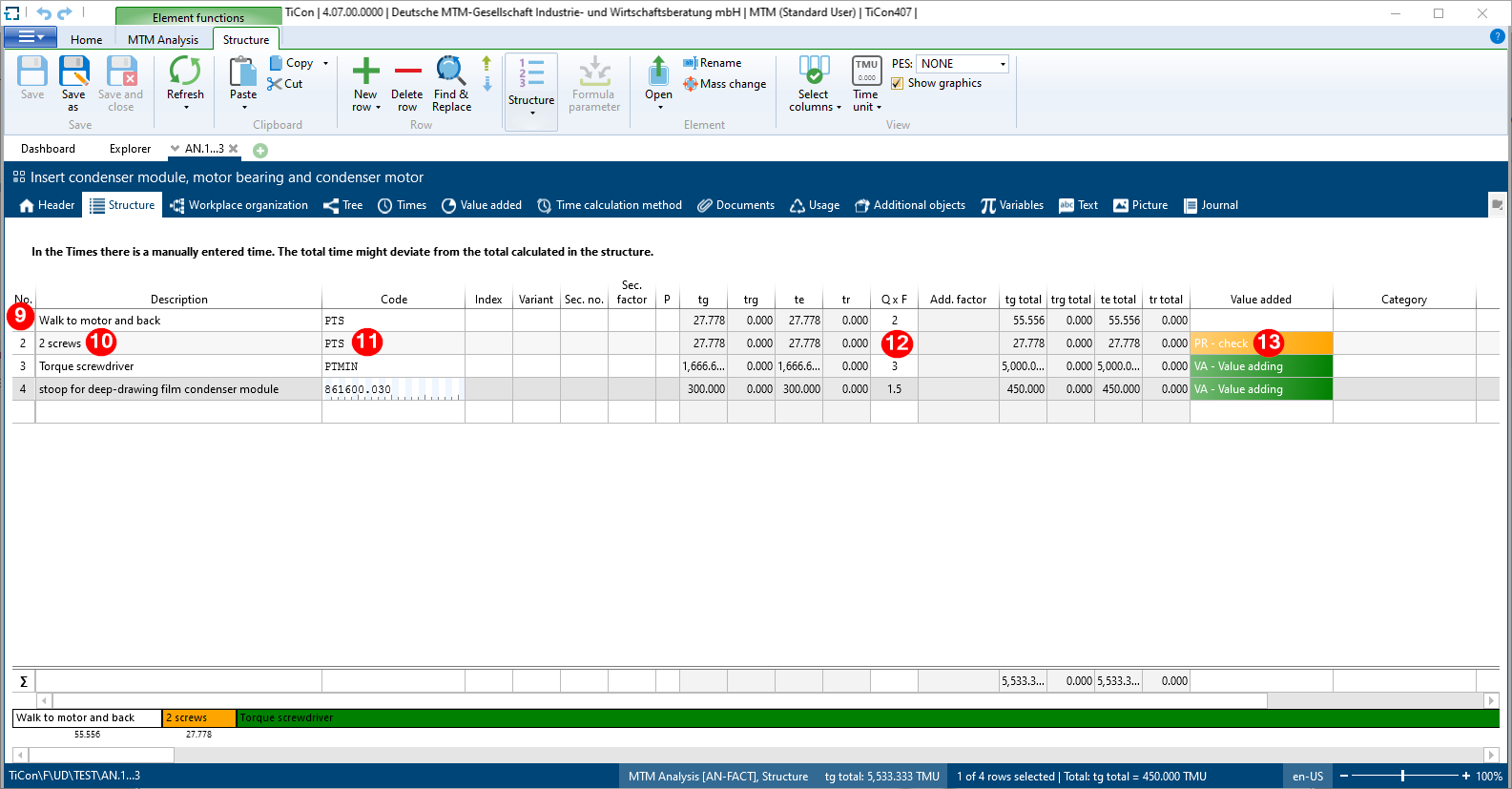
| No. | Content | Property Name and Remarks |
|---|---|---|
| 9 | Order number of structure row | entity.structure[].row.orderNumer |
| 10 | Description of used row element | entity.structure[].row.description.text |
| 11 | Code of used element | entity.structure[].row.elementUid and you have to set the typeEnum property to Element |
| 12 | Factorstring of usage | entity.structure[].row.factor |
| 13 | Indicators | entity.structure[].row.criterionUids[].IndicatorCriterion you need the Uid of indicator criterion, see chapter 6.6.7 |
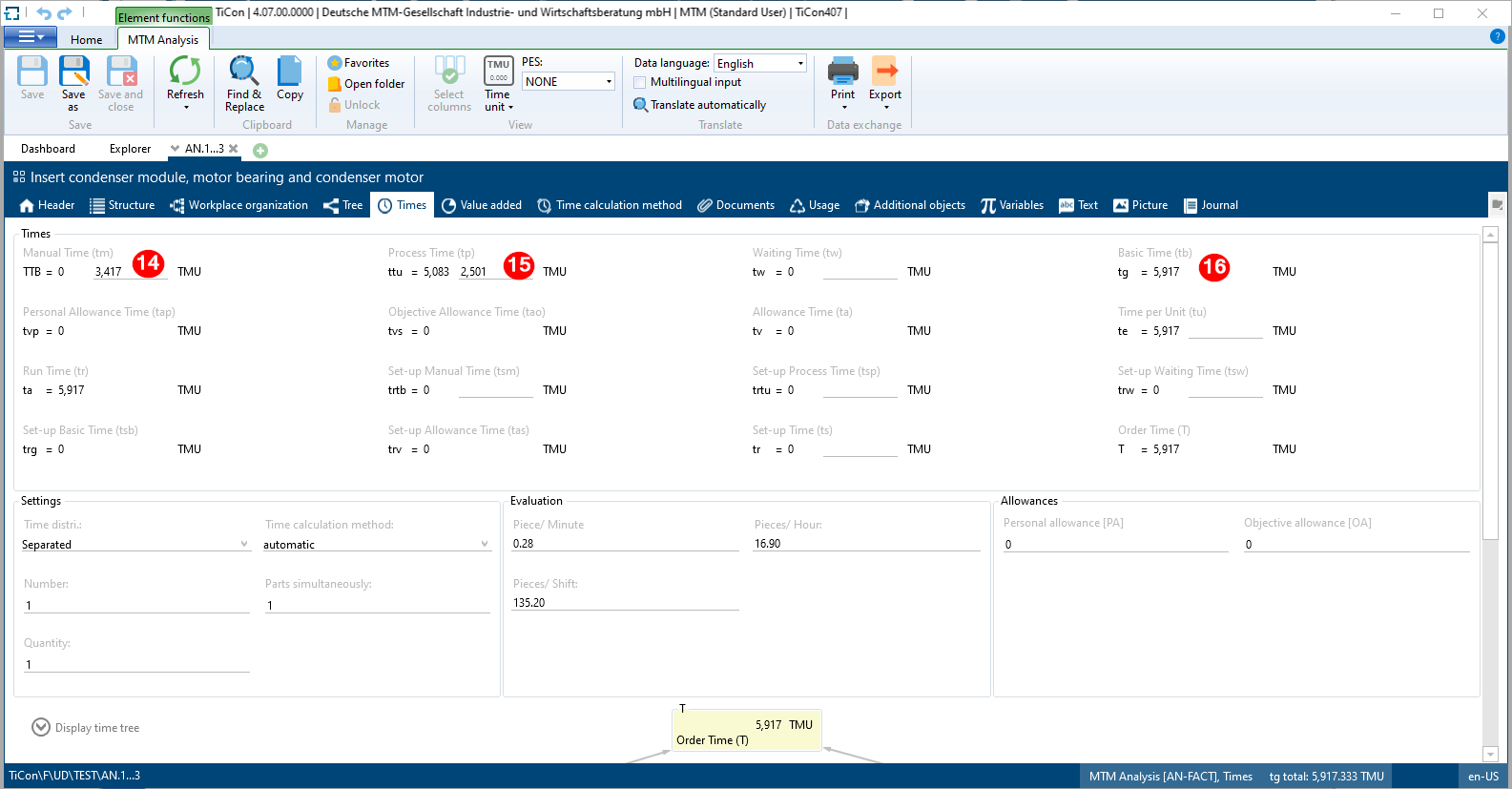
| No. | Content | Property Name and Remarks |
|---|---|---|
| 14 | Manual time | entity.times.ttbUser |
| 15 | Process time | entity.times.ttuUser |
| 16 | Basic time | is the sum from entity.times.ttbUser + entity.times.ttuUser |
Remarks
Please remember, all times have to be set in TMU.
2.1.4 Time element with an formula element in structure example
At next, here is a complex example to create a time element with an formula element in structure. Some formula parameters will be overriden in this example, see formulaValues in the structure row, you will find a variable definition (variables), which will override a formula value too.
[
{
"code": "AN.1...2",
"folderUid": "Folder-166",
"ownerUid": "Account-2",
"elementConfigurationUid": "ElementClassConfiguration-4101",
"description": {
"language": "en-US",
"text": "Time element with formula over Rest API",
"isSource": true
},
"begin": {
"language": "en-US",
"text": "with walking to condenser module",
"isSource": true
},
"end": {
"language": "en-US",
"text": "After returning torque screwdriver",
"isSource": true
},
"limit": {
"language": "en-US",
"text": "all activities within 2-m range"
},
"content": {
"language": "en-US",
"text": "Insert condenser module into frame, grease motor bearing and insert condenser module..."
},
"times": {
"ttu": 48807531.97912965,
"ttb": 178,
"ttuUser": 2500.6666666666665,
"tg": 48807758.97912965,
"te": 48807758.97912965,
"t": 48807758.97912965
},
"elementStatusUid": "ElementStatus-7",
"elementTypeUid": "ElementType-1",
"workorganizationType": "None",
"variables": [
{
"row": {
"code": "EV",
"typeEnum": "Default",
"value": 4
}
}
],
"structure": [
{
"row": {
"elementUid": "Element-14147",
"factor": "3",
"typeEnum": "FormulaElement",
"ordernumber": 1,
"description": {
"language": "en-US",
"text": "Formula with Rest API"
},
"formulaValues": [
{
"row": {
"ordernumber": 5,
"calculation": "pts",
"typeEnum": "FormulaValue"
}
},
{
"row": {
"calculation": "mix",
"ordernumber": 6,
"typeEnum": "FormulaValue"
}
},
{
"row": {
"ordernumber": 8,
"calculation": "13",
"typeEnum": "FormulaValue"
}
}
]
}
},
{
"row": {
"times": {
"ttb": 25,
"tg": 25,
"te": 25,
},
"elementUid": "Element-259",
"factor": "2",
"factorValue": 2,
"customFactor": "1",
"orderNumber": 2,
"typeEnum": "Element"
}
},
{
"row": {
"elementUid": "Element-14145",
"factor": "3",
"orderNumber": 3,
"typeEnum": "FormulaElement",
"description": {
"language": "de-DE",
"text": "another formula element"
},
"formulaValues": [
{
"row": {
"value": 6,
"calculation": "8",
"orderNumber": 1,
"typeEnum": "FormulaValue"
}
}
]
}
}
]
}
]
Remarks
When you use a formula in the structure of an time element, you have to inform you, about the structure of the formula element. Only with this information, you can override the formula parameters in the right way.
2.2 Update Time elements
To update a Time element with the TiCon4 REST API, you have to create a JSON structure in the request body and send it as a PATCH request. The JSON structure is as the same as discussed in chapter 2.1 It is necessary to know the Uid of the element you want to update.
Important: To change an element, all simple properties and dictionaries must be specified in the request body, regardless of whether their values have to be changed or not! Exceptions are navigation properties and properties of type LocaleText like description, begin, end.
Use the following call to patch a Time element:
{{ServerAddress}}/ticon-web/services/data/time-elements
2.2.1 Simple example
At first an example how to update the texts field of the Time element in the header view.
[
{
"code": "AN.1...3",
"folderUid": "Folder-130",
"ownerUid": "Account-2",
"elementConfigurationUid": "ElementClassConfiguration-100013",
"description": {
"language": "en-US",
"text": "change the description with TiCon4 REST API"
},
"begin": {
"language": "en-US",
"text": "change the starts with TiCon4 REST API"
},
"end": {
"language": "en-US",
"text": "change the ends with TiCon4 REST API"
},
"limit": {
"language": "en-US",
"text": "change limitations with TiCon4 REST API"
},
"content": {
"language": "en-US",
"text": "simple change example with TiCon4 REST API"
},
"uid": "Element-14719",
"elementStatusUid": "ElementStatus-7",
"elementTypeUid": "ElementType-1",
"workorganizationType": "None"
}
]
The table below lists where to find the data numbered in the TiCon screenshot.
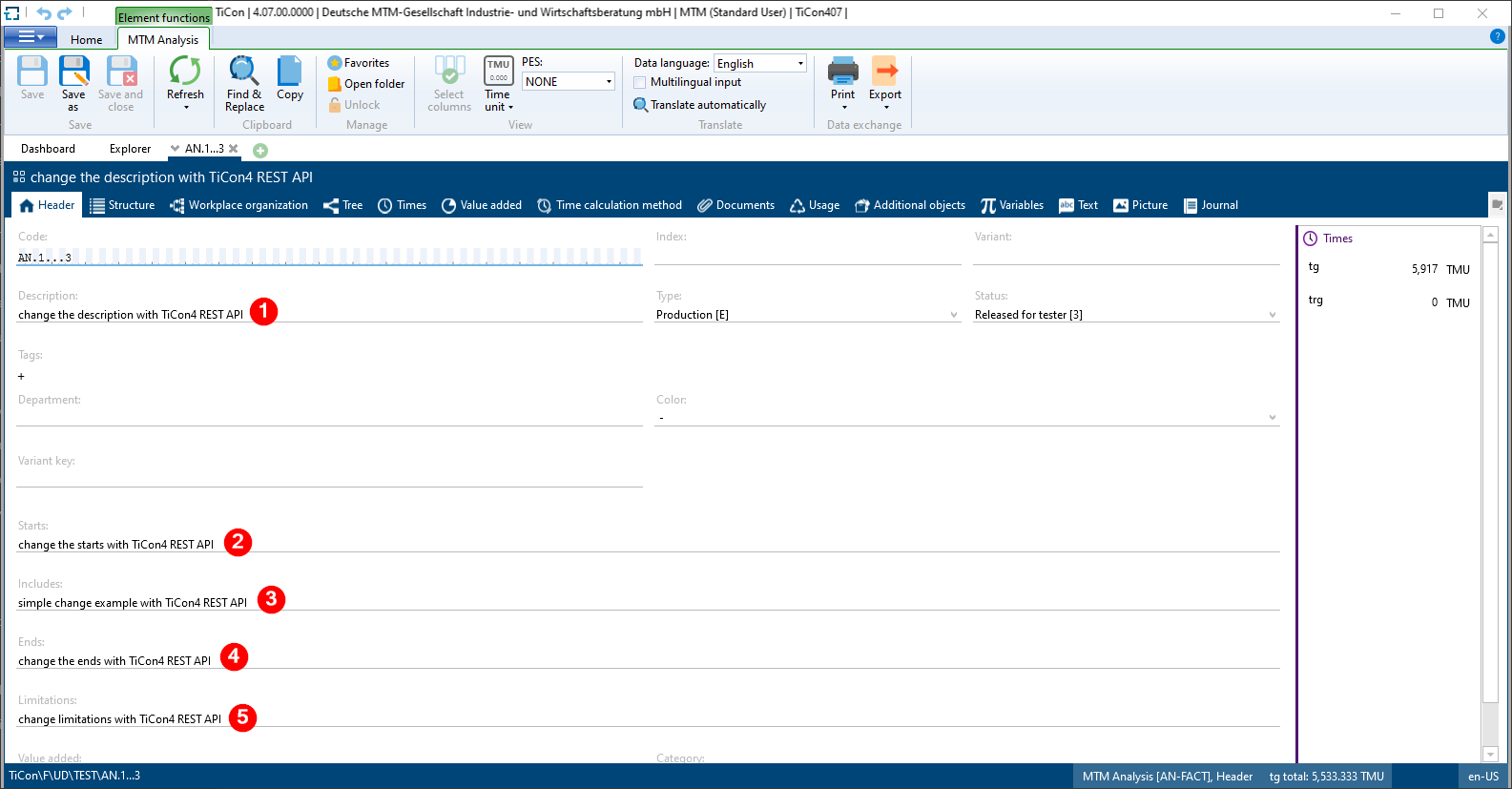
| No. | Content | Property Name and Remarks |
|---|---|---|
| 1 | Description of element | entity.description.text |
| 2 | Start of element | entity.begin.text |
| 3 | Includes of element | entity.content.text |
| 4 | Ends of element | entity.end.text |
| 5 | Limitations of element | entity.limit.text |
2.2.2 Full example
At next a full patch example of a Time element. To change the structure of the Time element, you have to add a whole JSON structure with the original identifiers and do your changes inside (i.a. texts, indicator criterions). When you want to add a new row, don't add the property identifier, if you want to delete a row, don't mention this row, see example below.
[
{
"elementConfigurationUid": "ElementClassConfiguration-100013",
"description": {
"language": "en-US",
"text": "change the description with TiCon4 REST API"
},
"begin": {
"language": "en-US",
"text": "change the starts with TiCon4 REST API"
},
"end": {
"language": "en-US",
"text": "change the ends with TiCon4 REST API"
},
"limit": {
"language": "en-US",
"text": "change limitations with TiCon4 REST API"
},
"content": {
"language": "en-US",
"text": "simple change example with TiCon4 REST API"
},
"code": "AN.1...4",
"folderUid": "Folder-130",
"ownerUid": "Account-2",
"index": 1,
"uid": "Element-14719",
"times": {
"ttbUser": 2500.665,
"ttu": 3416.6666666666665,
"ttuUser": 2300,
"twUser": 2500,
"tg": 3416.6666666666665,
"te": 3416.6666666666665,
"t": 3416.6666666666665
},
"elementTypeUid": "ElementType-2",
"elementStatusUid": "ElementStatus-7",
"workorganizationType": "None",
"structure": [
{
"identifier": "173119",
"row": {
"elementUid": "Element-1005",
"factor": "2.5",
"ordernumber": 1,
"typeEnum": "Element",
"description": {
"language": "en-US",
"text": "Changed with TiCon4 REST API"
},
"criterionUids": [
{
"key": "1",
"value": "IndicatorCriterion-10003"
}
]
}
},
{
"identifier": "173120"
},
{
"identifier": "173121"
},
{
"identifier": "173122"
},
{
"row": {
"elementUid": "Element-13605",
"factor": "1.0",
"ordernumber": 5,
"typeEnum": "Element",
"description": {
"language": "en-US",
"text": "stoop for deep-drawing film condenser module"
},
"criterionUids": [
{
"key": "1",
"value": "IndicatorCriterion-10003"
}
]
}
}
]
}
]
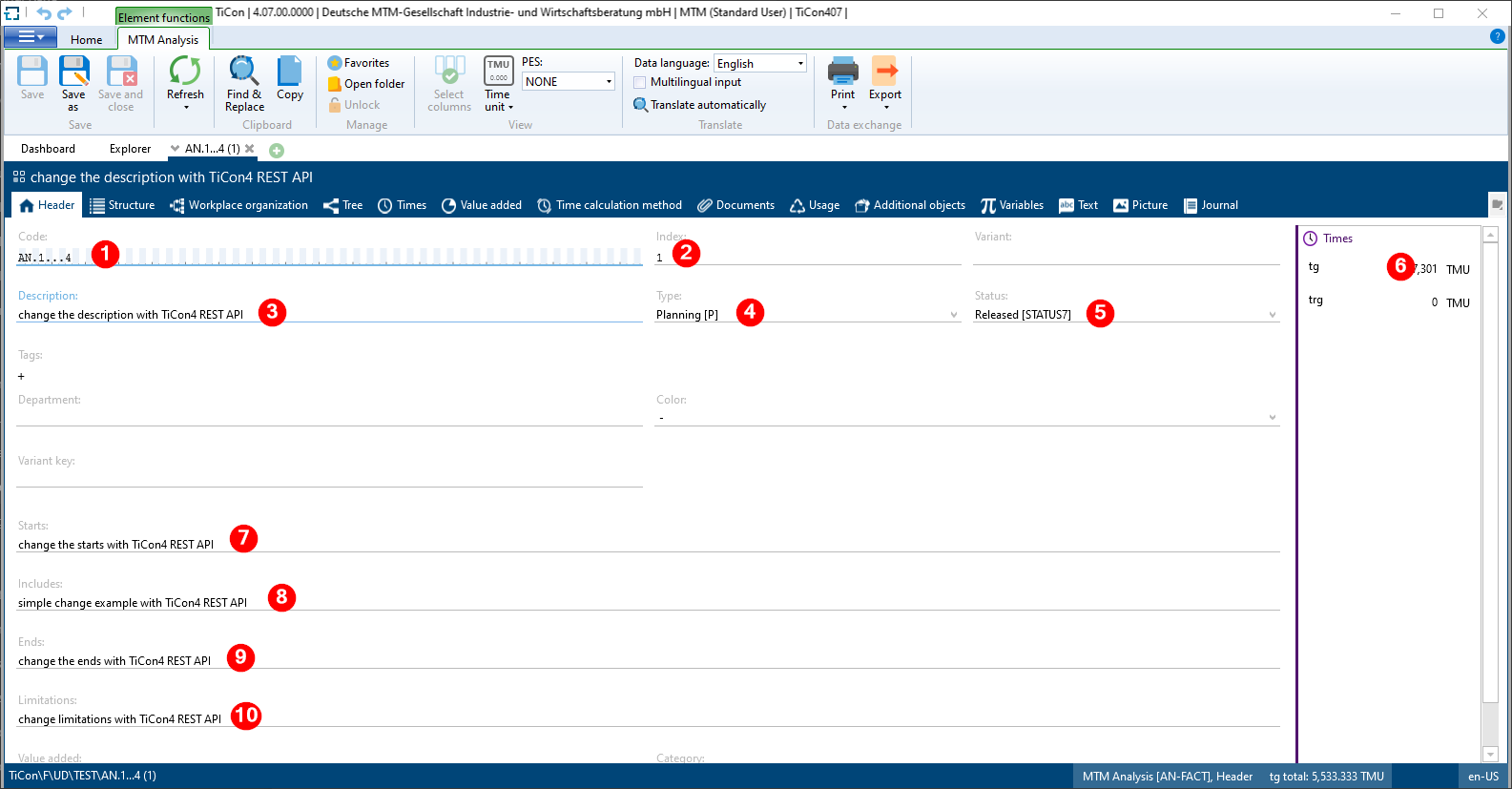
| No. | Content | Property Name and Remarks |
|---|---|---|
| 1 | Cod of element | entity.code |
| 2 | Index of element | entity.index |
| 3 | Description of element | entity.description.text |
| 4 | Type of element | entity.elementTypeUid you need the Uid of element type, see chapter 6.6.5 |
| 5 | Status of element | entity.elementStatusUid you need the Uid of element status, see chapter 6.6.6 |
| 6 | Basic time of element | entity.times.tg |
| 7 | Start of element | entity.begin.text |
| 8 | Includes of element | entity.content.text |
| 9 | Ends of element | entity.end.text |
| 10 | Limitations of element | entity.limit.text |
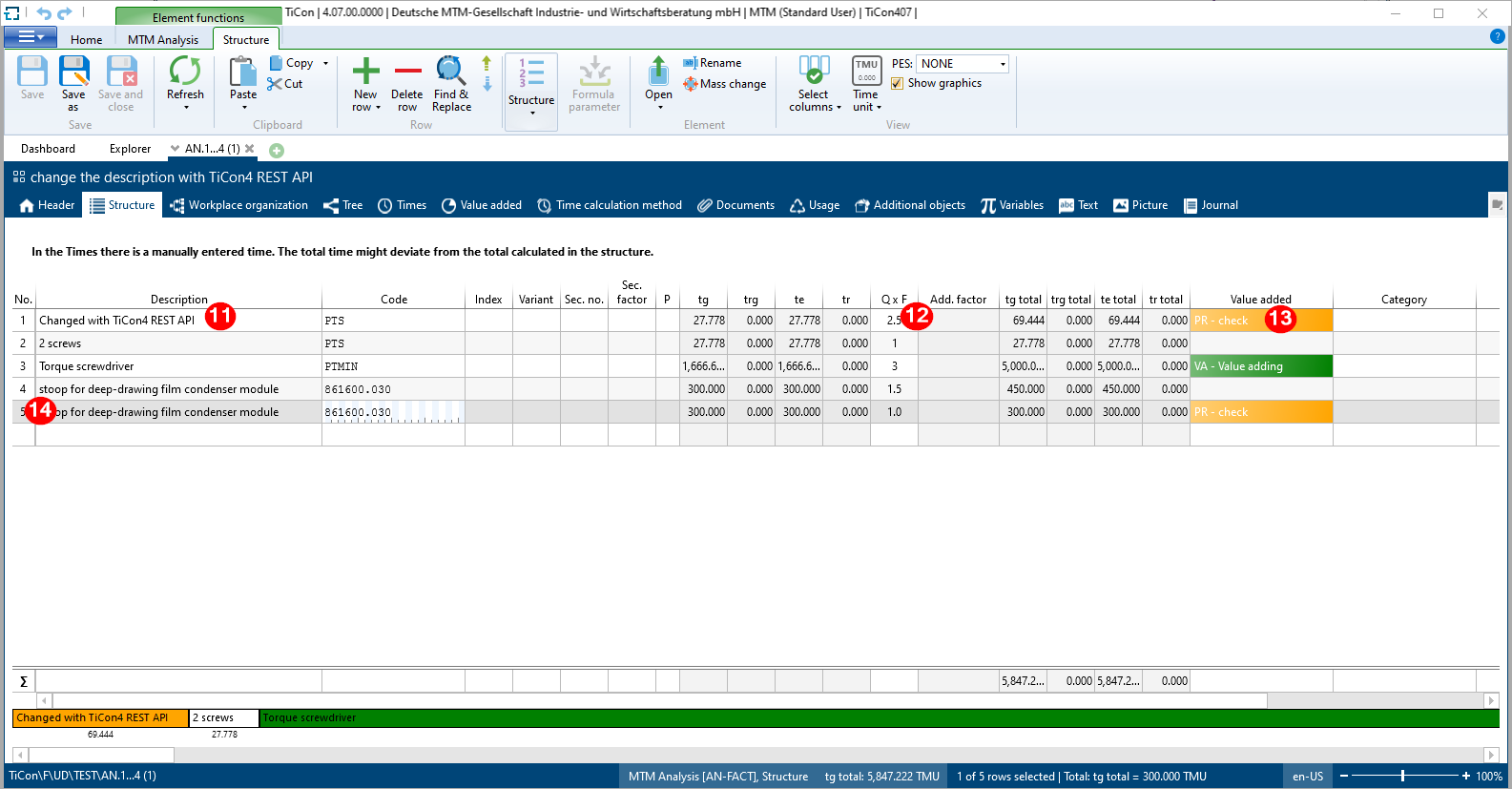
| No. | Content | Property Name and Remarks |
|---|---|---|
| 11 | Description of used row element | entity.structure[].row.description.text |
| 12 | Factorstring of usage | entity.structure[].row.factor |
| 13 | Indicators | entity.structure[].row.criterionUids[].IndicatorCriterion you need the Uid of indicator criterion, see chapter 6.6.7 |
| 14 | Order number of structure row | entity.structure[].row.orderNumer |
Remarks
Please remember, all times have to be set in TMU.
2.3 Formula elements
The next chapter will describe how to create a new Formula element with the TiCon4 REST API. To create a new element, you have to create a JSON structure in the request body and send it as a POST request. Following properties are mandatory:
- Code
- folderUid
- ownerUid
- elementConfigurationUid
- calculation
To create a new Formula element with the TiCon4 REST API you have to call the following URL:
{{ServerAddress}}/ticon-web/services/data/formula-elements
2.3.1 Simple example
At first a very simple example, to create a Formula element with code and a certain element class configuration, the user needs the minimum permission write .
[
{
"code": "SIMPLE.FORMULA.EXAMPLE",
"calculation": "PI * 3,043",
"folderUid": "Folder-131",
"ownerUid": "Account-2",
"elementStatusUid": "ElementStatus-3",
"elementTypeUid": "ElementType-1",
"elementConfigurationUid": "ElementClassConfiguration-4501"
}
]
2.3.2 Full example
Here a full example of a Formula element.
[
{
"code": "FULL.FORMEL.EXAMPLE",
"calculation": "PI * 3,043",
"folderUid": "Folder-131",
"ownerUid": "Account-2",
"formulaType": "Time",
"timeType": "Ttu",
"courseOfTimeType": "Separate",
"elementStatusUid": "ElementStatus-3",
"elementTypeUid": "ElementType-1",
"elementConfigurationUid": "ElementClassConfiguration-4501",
"description": {
"language": "de-DE",
"text": "Komplettes Formelbeispiel mit der Rest API"
},
"formulaCriterionUids": [
{
"key": "1",
"value": "IndicatorCriterion-10003"
}
],
"structure": [
{
"row": {
"variable": "L",
"timeType": "Ttu",
"parameterType": "Variable",
"orderNumber": 1,
"defaultInput": "2 * 1,0",
"description": {
"language": "de-DE",
"text": "Variable L"
}
}
},
{
"row": {
"variable": "I",
"timeType": "Ttu",
"parameterType": "Variable",
"orderNumber": 2,
"min": 1,
"max": 10,
"description": {
"language": "de-DE",
"text": "Variable I"
}
}
}
]
}
]
Remarks
The defaultInput has a default value of 1 * 1.0 when the parameterType is Variable or Constant. The REST API calculates the default value automatically.
2.4 Update Formula elements
To update a Formula element with the TiCon4 REST API, you have to create a JSON structure in the request body and send it as a PATCH request. The JSON structure is as the same as discussed in chapter 2.3 It is necessary to know the Uid of the element you want to update.
Use the following call to patch a Formula element:
{{ServerAddress}}/ticon-web/services/data/formula-elements
2.4.1 Example
Here a full example, where you can see, how to update a Formula element.
[
{
"code": "FULL.FORMEL.EXAMPLE...CHANGED",
"calculation": "PI * 14",
"folderUid": "Folder-131",
"ownerUid": "Account-2",
"formulaType": "Time",
"timeType": "Ttu",
"courseOfTimeType": "Separate",
"elementStatusUid": "ElementStatus-3",
"elementTypeUid": "ElementType-1",
"elementConfigurationUid": "ElementClassConfiguration-4501",
"uid": "Element-13578",
"description": {
"language": "de-DE",
"text": "Beispiel Text, geändert mit REST API"
},
"formulaCriterionUids": [
{
"key": "1",
"value": "IndicatorCriterion-10002"
}
],
"structure": [
{
"row": {
"variable": "L",
"timeType": "Ttu",
"parameterType": "Variable",
"orderNumber": 1,
"defaultInput": "4 * 1,5",
"description": {
"language": "de-DE",
"text": "Beispiel Variable L"
}
},
"identifier": "169832"
},
{
"row": {
"variable": "I",
"timeType": "Ttu",
"parameterType": "Variable",
"orderNumber": 2,
"min": 1,
"max": 5
},
"identifier": "169833"
}
]
}
]
2.5 Reading and writing criteria
Criteria are used to store individual data on any element within TiCon. Criteria are created in the TiCon Admin. There you can define a code, to identify the criterion, and basic settings like a description, a type (text, number, date, …) and additional data. After that a criterion must be assigned to an element configuration.
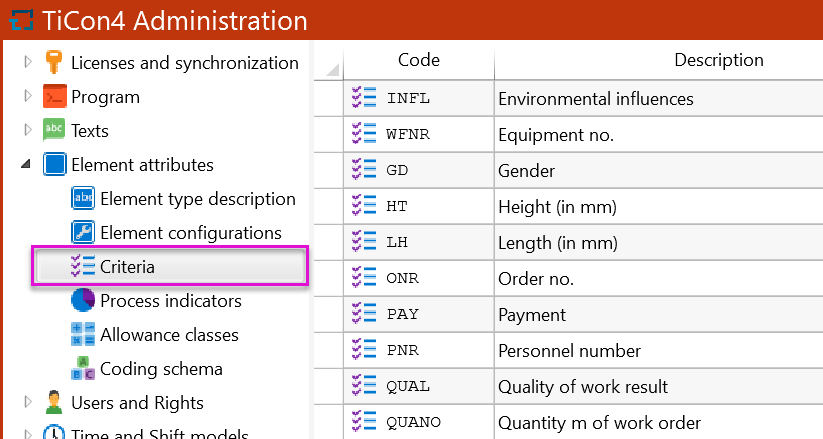
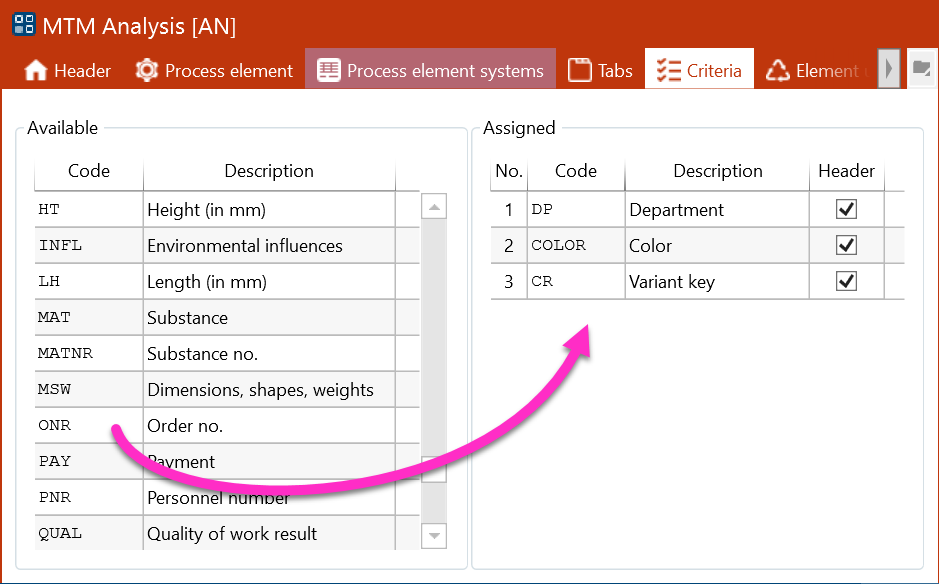
Definition of criteria in TiCon Admin and assignment of criteria to element configurations in TiCon Admin.
Criteria can be used with any element type, such as time elements, formula elements, product work piece elements and so on.
The following examples demonstrate the usage with time elements. If you want to work with other types, you must use the corresponding end points and the json required for the element type. However, the criteria part will always be the same.
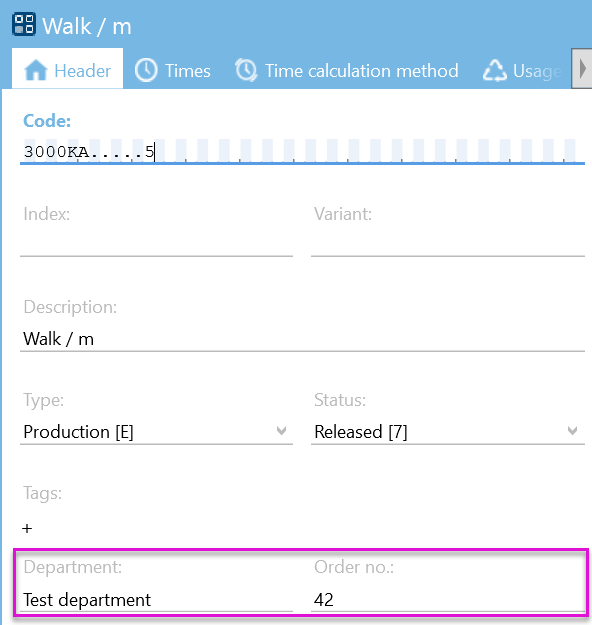
Display of criteria values in TiCon client.
The easiest way to start is to create an element within TiCon and afterwards query this element to see the required json.
With the following query you receive this json. It contains two criteria, a text criteria with the code DP and the value of “Test department” and a number criteria with the code ONR with the value of 42.
GET {{ServerAddress}}/ticon-web/services/data/time-elements?code=3000KA.....5&expand[criteria][row]
{
"entities": [
{
"elementStatusUid": "ElementStatus-7",
"elementTypeUid": "ElementType-1",
"elementConfigurationUid": "ElementClassConfiguration-4104",
"folderUid": "Folder-20",
"criteria": [
{
"row": {
"elementCriterionUid": "ElementCriterion-1006",
"textValue": "Test department",
"elementCriterionCode": "DP"
},
"identifier": "19323"
},
{
"row": {
"elementCriterionUid": "ElementCriterion-1044",
"numberValue": 42,
"elementCriterionCode": "ONR"
},
"identifier": "30186"
}
],
"code": "3000KA.....5",
"objectType": "TimeElement",
"uid": "Element-259"
}
],
"expanded": []
}
You can read the criterion''s code in the property elementCriterionCode and the Uid in the property elementCriterionUid. The value is stored depending on the type of the criterion in the properties:
- numberValue for numeric and boolean criteria
- textValue for alpha numeric and date criteria
- fixedCriterionValueCode and fixedCriterionValueUid for criteria with value lists
- If there is none of these fields the value of the criterion is null.
To create an element with a criteria value you can recycle the json received with the GET request. If you want to create an element with the same criteria value as in the above example you may use the following json.
POST {{ServerAddress}}/ticon-web/services/data/time-elements?lang=en-US
[
{
"workOrganizationType": "BreaksEveryTime",
"elementStatusUid": "ElementStatus-3",
"elementTypeUid": "ElementType-1",
"elementConfigurationUid": "ElementClassConfiguration-4101",
"folderUid": "Folder-10",
"criteria": [
{
"row": {
"elementCriterionUid": "ElementCriterion-1006",
"textValue": "Test department",
"language": "en-US"
}
},
{
"row": {
"elementCriterionUid": "ElementCriterion-1044",
"numberValue": 42,
"language": "en-US"
}
}
],
"code": "MY-DEMO-ELEMENT",
"objectType": "TimeElement"
}
]
To update the criteria on existing elements you can use the following json. You have to input the element uid of the element you want to change and the criterion uid of the criterion you want to change. If you like you can change the value of multiple criteria by sending more rows. Unspecified criteria will not be changed.
PATCH {{ServerAddress}}/ticon-web/services/data/time-elements?lang=en-US
[
{
"criteria": [
{
"row": {
"elementCriterionUid": "ElementCriterion-1006",
"textValue": "Changed Department",
"language": "en-US"
}
}
],
"uid": "Element-14250"
}
]
3 Data structure in TiCon
In TiCon we distinguish between Administration Data and Element Data. Element Data refers to all elements stored within TiCon, that the TiCon user regularly works with. These elements can be Time Elements, also known as analyses or Balancing elements, and others. Time Elements are built by the composition of other Time Elements, like MTM basic time elements as the UAS elements KA, AA1 etc.
Each element has some basic data like a folder where a code, index, variant, and description are stored, and even more. Folder, code, index, and variant form a natural unique key. Furthermore, there is an artificial unique key to identify elements.
Each type of element - we call them element class - has additional unique properties. Besides the element class, which identifies the type of the element there is a so-called element configuration that controls what data is visible to the user and how the element can be composed from others, as well as, user rights that are given to the different configurations.
4 Concepts of the API
4.1 Design philosophy - General design decisions
4.1.1 Orthogonality
The CRUD operations with entities are orthogonal. That is: the REST endpoints are different, but the same parameters in the same format can be used for all these REST endpoints. Also, the JSON formats in request and response are the same, apart from the entity's different object type in each case.
The advantage of orthogonal APIs is that they are easier to use, because the parameter set and the request/response object only need to be understood once and can then be applied to all endpoints.
4.1.2 Idempotency
The CRUD operations GET and PATCH with entities are idempotent. That is, the same REST call with the same parameters produces the same state on the server and returns the same response.
Multiple identical GETs return the same response and do not change the state on the server, so the operation is idempotent. Multiple identical PATCHes change the state on the server, but in an identical way, and return the same response. The operation is therefore idempotent.
A POST creates multiple entities with different UIDs when called multiple times. The operation is therefore not idempotent.
A DELETE returns an error on the second call, since the resource with the specified UID is then no longer available. The operation is therefore also not idempotent.
4.1.3 GET-by-URL
Reading operation with the GET verb hold all the parameters entirely in the URL (except authorization data if any authorization is used).
That is: a GET call for entities can be reproduced by simply copying the URL. There is no "hidden" parameter part in the header.
4.1.4 No OData
The API is not OData compliant because it doesn't add any value to the supported use cases, and would increase complexity and implementation effort as well as limiting the API's flexibility.
4.1.5 Extensibility and backward compatibility
The API will be kept backward compatible in recent subsequent versions so that older clients can work with servers that use newer API versions.
This imposes the following constraints for API extensions:
- new endpoints with new parameters and new data models may always be introduced
- existing endpoints will be kept backward compatible, i.e:
- new parameters may be added, but they will be optional, because old clients do not use these parameters, and the default case (i.e., without specifying the parameter) will behave the same as the old version of the API
- existing parameters (and data models) may be extended by new properties, but these properties will also be optional, and the default case will again behave like in the old version of the API (see above)
- GET may provide more complex data models than in the old API, the old client should ignore the additional properties.
To obtain the current version number you may call {{ServerAddress}}/ticon-web/services/management/version (GET).
4.1.6 High-level API and dumb clients
The TiConWeb API is supposed to be a high-level API. This means fewer, but more large-scale server requests. An API operation combines more functionality in itself, so it has a higher level of abstraction.
Examples
- Create time elements with structure and time vector in one POST request instead of creating time vector and structure first by several single requests.
- Request rendered data card from server instead of requesting all needed information by 100 single requests, in order to render it on the client.
This has the following advantages
- Better performance, especially shorter response time for users.
- The server has to trust the client less, which is very important, especially in the cloud environment. The correct flow control is ensured on the server side. A client can also not maliciously cause damage if it takes over the flow control itself, e.g. through:
- Connection failures or browser crashes while the client is in the middle of a flow (e.g., creating or deleting a time block)
- Implementation errors in the client
- Easier usability of the API, better implementability of the client. Client needs less concrete knowledge about data models, flow control and business logic (Dumb Client). These are encapsulated as implementation details on the server side.
- Better flexibility / extensibility of the API. Due to fewer adjustments required to the client in case of changes to the API.
4.1.7 Data multilingualism and translations
The TiConWeb API supports data multilingualism. However, in the CRUD operations with entities, only one language is transmitted. This corresponds to the workflow of the functional modification of a text, which is done with the language of the current user.
For translation, there are dedicated endpoints that allow reading / writing of all translations for each property.
4.2 CRUD operations with entities
4.2.1 Entities versus Models
We distinguish two types of data in the API:
- Entities - objects than can live on their own with their own UId in the database. For each entity type there is a separate REST endpoint to perform CRUD operations with the corresponding entities.
- Models - objects that are also persisted in the database, but are used only as a substructure of exactly one entity.
Examples of models are the time vector and structure lines in time elements. Whereas an example of an entity is a time element, and indicator criteria as it is used not only within indicator categories, but also from time elements and structure lines.
Models differ from entities on the data side in the following ways:
- From a database perspective, a Model can be a standalone Entity - with its own Id or UId - but it does not have to be. This is an implementation detail of the backend, and from a REST perspective is abstracted away.
- Models (from REST point of view) don't have UIds either, because not every backend has UIds for models
- Models do not have their own REST endpoints either. Only entities have REST endpoints
4.2.2 IDs versus UIDs
From a REST perspective, entities always have a UId. UIds and Ids are not the same thing:
- UId - identifies the object globally, regardless of the object type.
- Id - identifies the object within a type or type hierarchy (source table). Only the tuple (Id, origin table) therefore identifies the object globally.
For example, in the TiCon4 database a folder can have Id 42 and a time element can have Id 42. However, two time elements can not share the same Id, as they are stored in the same table.
In the API the UId is always constructed by the object name and it's Id, e. g.: Folder-20.
5. Authorization
In TiCon REST API the user can configure the authorization by the following ways:
- Basic Auth
- OAuth 2.0
Before you can use the API, you have to configure the authorization scheme in the app settings. You can set the property AuthenticationType to Basic or OAuth2, if it is not set, the fall back is always Basic. When the authorization scheme is set to OAuth2, you have to configure the EntraId or Google configuration section in the app settings. If you set the property to Basic, nothing else is to do.
5.1 Basic Authentication
This API uses the Basic Authentication scheme. In context of an HTTP transaction, basic access authentication is a method for an HTTP user agent to provide a username and password when making a request. Every request contains a header field in the form of Authorization: Basic <credentials>, username and password splitted by a single colon.
The credentials are built by the TiCon username and the corresponding password. A REST endpoint will only provide the data the corresponding TiCon user would be able to see. Writing (creating, updating, and deleting) is handled in the same way.
5.2 OAuth 2.0
The TiCon REST API supports OAuth 2.0 for authorization. OAuth 2.0 is the industry-standard protocol for authorization. It focuses on client developer simplicity while providing specific authorization flows for web applications, desktop applications and mobile phones. At the moment the API supports Entra ID and Google as OAuth providers.
5.2.1 Entra ID
Entra ID is a single sign-on solution from Microsoft, former known as Azure AD, that allows users to log in to multiple applications with one set of credentials. The TiCon REST API supports Entra ID as OAuth provider. To use Entra ID as OAuth provider, the user has to log in with his Microsoft credentials. The user will be redirected to the Microsoft login page. After successful login, the user will get an Access token, that can use for all protected endpoints.
To configure the API to use Entra ID, set AuthenticationType to oauth2 and configure the EntraId section in the app settings, after your administrator created an App registration in Azure portal.
5.2.1.1 Configuration in Azure
To use the API with Entra ID, you have to register it in the Azure portal. You have to create a new App registration and set the redirect URI to the URL of your API development tool, for example the Postman redirect URL is https://oauth.pstmn.io/v1/callback. In the Authentication section of the Azure portal you also have to check the options
- Access tokens (used for implicit flows)
- ID tokens (used for implicit and hybrid flows)
In Certificates & secrets you have to create a new client secret. The client secret is the password for the API. You have to copy the secret and save it in the API development tool that you use, see chapter 5.2.1.2. Also important is to create an Scope under Expose an API section in Azure portal.
If you have more technical questions, please ask your system administrator.
Remarks:
The API supports swagger Open API, if you want support authentication in swagger, you have to add the redirect URI of your Open API in Azure portal: https://xxx/swagger/oauth2-redirect.html. xxx is your root address of the API.
5.2.1.2 Configuration in API development tool
This chapter will show you, how to configure an API development tool, to use Entra ID as authentication provider. The following example is for Postman, but you can use the same configuration for other tools.
The very important part is the Authorization tab. You have to set the type to OAuth 2.0 and set Add authorization data to Request Headers, the Header Prefix is Bearer.
In Azure portal of the App registration you will find your endpoint URLs for the Auth and Access Token URL. The Callback URL in Postman is https://oauth.pstmn.io/v1/callback, the Client ID, Client Secret and Scope you have to copy from the Azure portal. Your settings could look as the picture below.
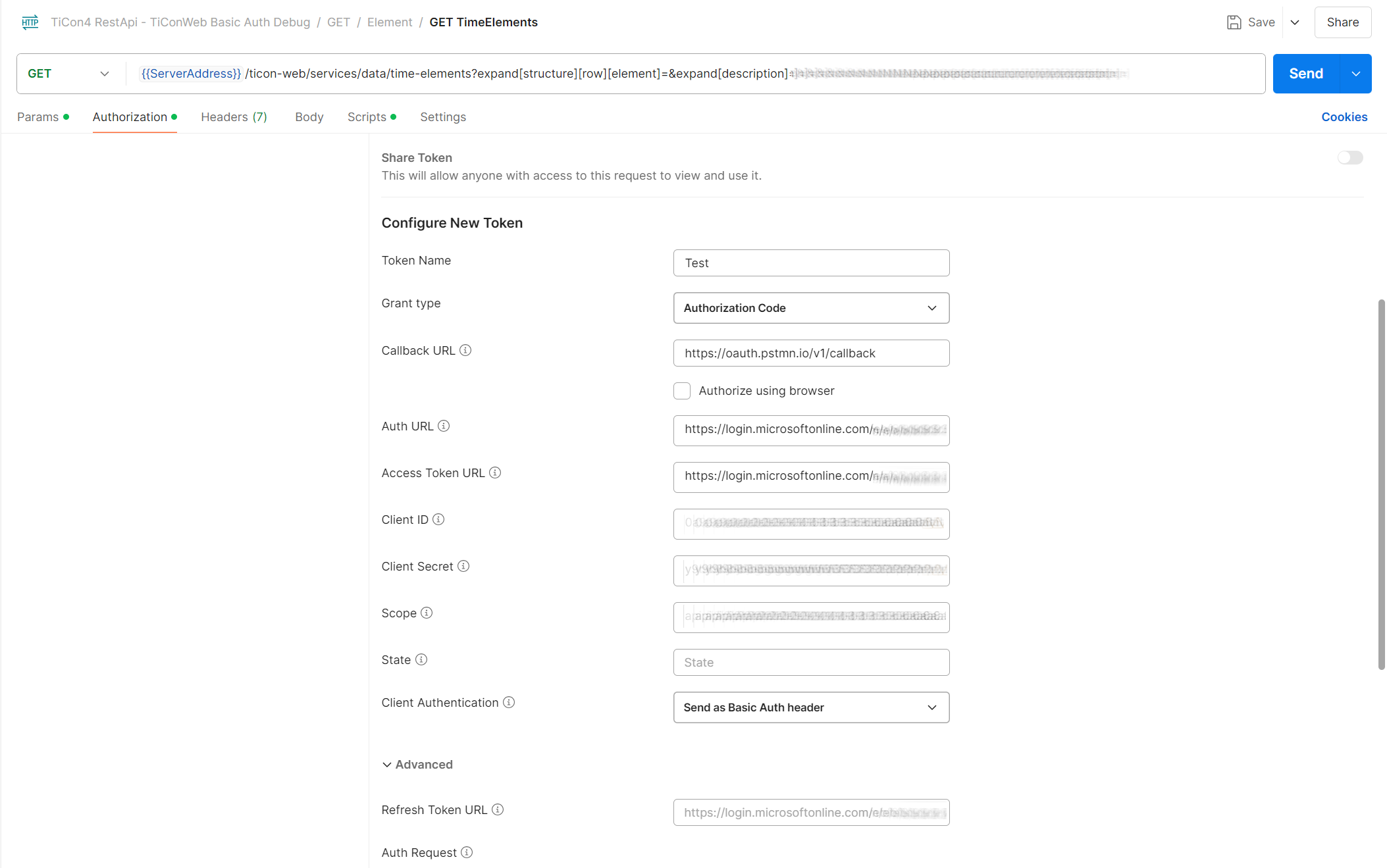
After all settings are done, you can click on the Get New Access Token button. You will be redirected to the Microsoft login page. After successful login, you will get an Access token. Postman will ask you, if you want to use that token, see screenshot.
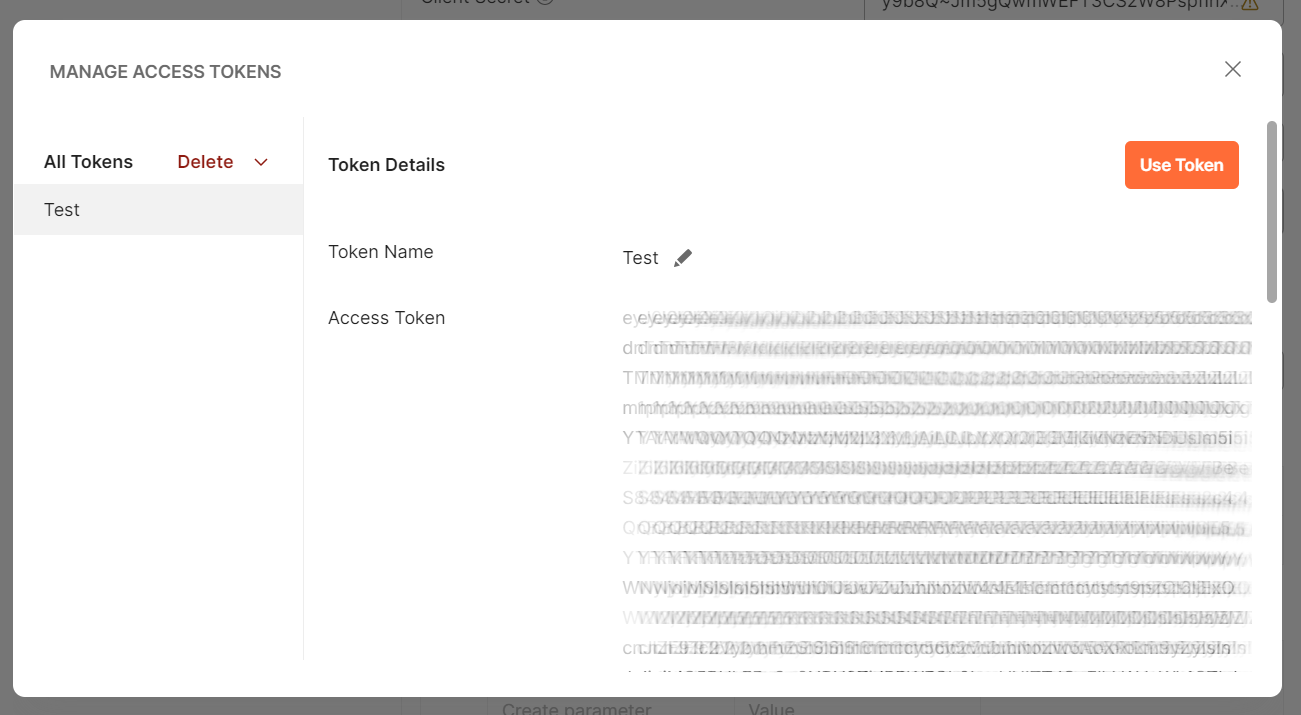
Now you can use this token for all protected endpoints, until the token is expired/invalid. When this is happened, you have to renew the access token, by clicking Get New Access Token.
In Postman you have the possibility to create an Environment set, there you can add variables for Client ID, Client Secret or the Scope, if you work with different API URIs or different authentication schemes, see screenshot.
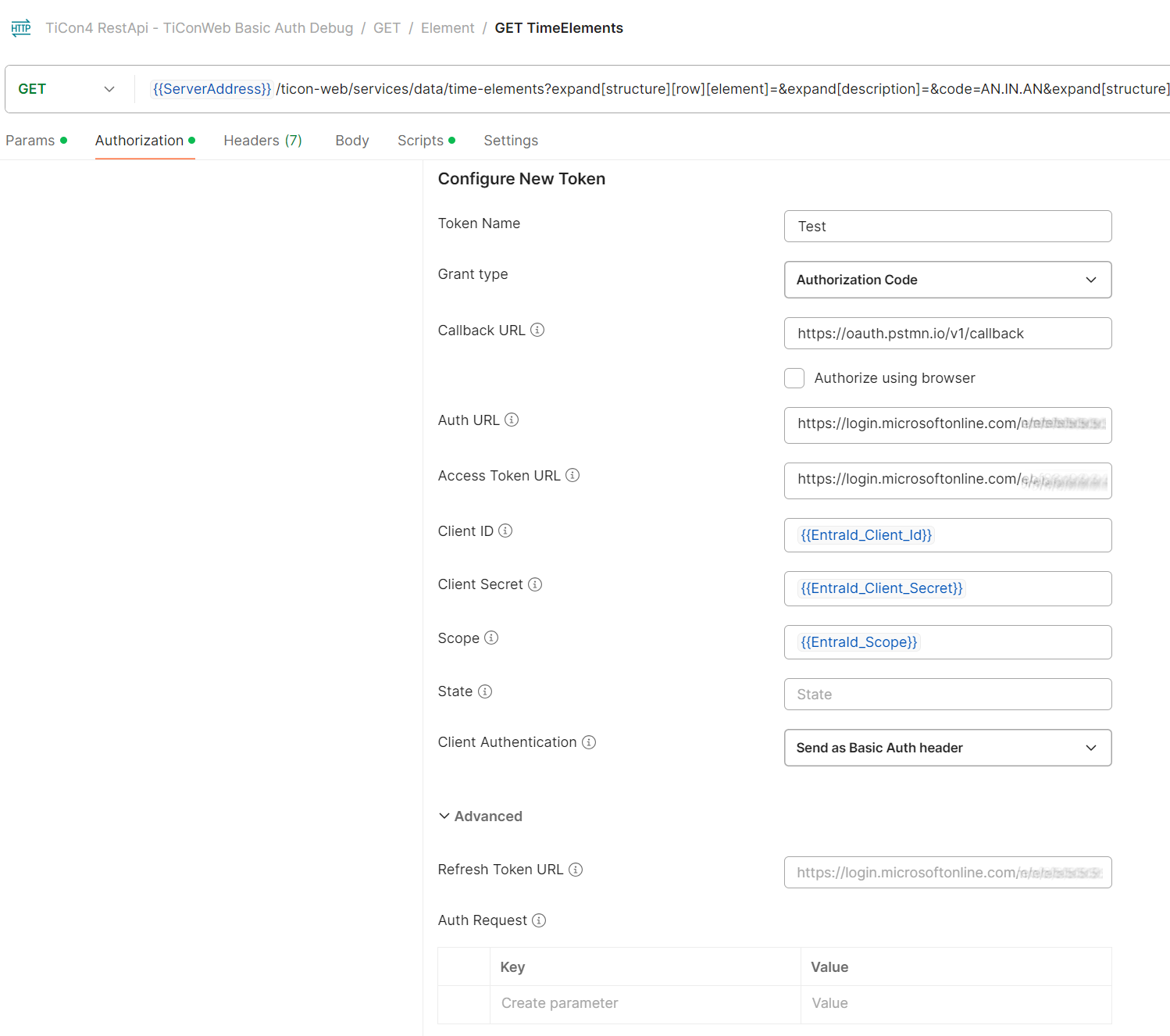
5.2.2 Google Cloud Platform
With the Google Cloud Platform, it is possible to use Google as an OAuth provider. The user has to log in with his Google credentials. The user will be redirected to the Google login page. After successful login, the user will get an Access token, that can use for all protected endpoints.
To configure the API to use the Google Cloud Platform, set AuthenticationType to oauth2 and configure the Google section in the app settings, after your administrator created an App project in the Google Cloud if it doesn't exists.
5.2.2.1 Configuration in Google
In Google Cloud Platform your system administrator have to create a new project in APIs and services if no project already exists. After the project is successfully created, under Credentials add the API as new OAuth client ID. The application type is Web application, configure the Authorised redirect URIs and at the end click Create. In the overview of OAuth 2.0 Client IDs appears the API as new entry. When you click on the new created Client ID for Web application, you can see the Google Client ID and Client secret, this two values are important for your development tool and API configuration.
Now your API Google Cloud configuration is in Testing mode, see OAuth consent screen, here you can add test users, to test your current Google Cloud configuration. When all works fine, publish your configuration into Production mode, by pressing the button Publish App.
Remarks:
Google recommend that you don't need this step, when you use the API only for internal purposes, or for testing, or when only a small group of users uses the API.
The API supports swagger Open API, if you want support authentication in swagger, you have to add the redirect URI of your Open API in Google Clout Platform: https://xxx/doc-rest-api/oauth2-redirect.html. xxx is your base address of the API.
5.2.2.2 Configuration in API development tool
Now we want discuss, how to configure the development tool to use the Google Cloud Platform as authentication provider.
The very important part is the Authorization tab. You have to set the type to OAuth 2.0 and set Add authorization data to Request Headers, the Header Prefix is Bearer.
In your API development tool set the following values:
- Callback URL is the redirect URI, you set in the Google Cloud Platform, the Postman Callbakc URL is
https://oauth.pstmn.io/v1/callback - The Google Cloud Platform Auth URL is
https://accounts.google.com/o/oauth2/v2/auth - The Google Cloud Platform Access Token URL is
https://oauth2.googleapis.com/token - The Client ID and Client Secret you can find in the Google Cloud Platform API configuration section
- As Scope you can use
email
Here you can see a screenshot from a Postman configuration:
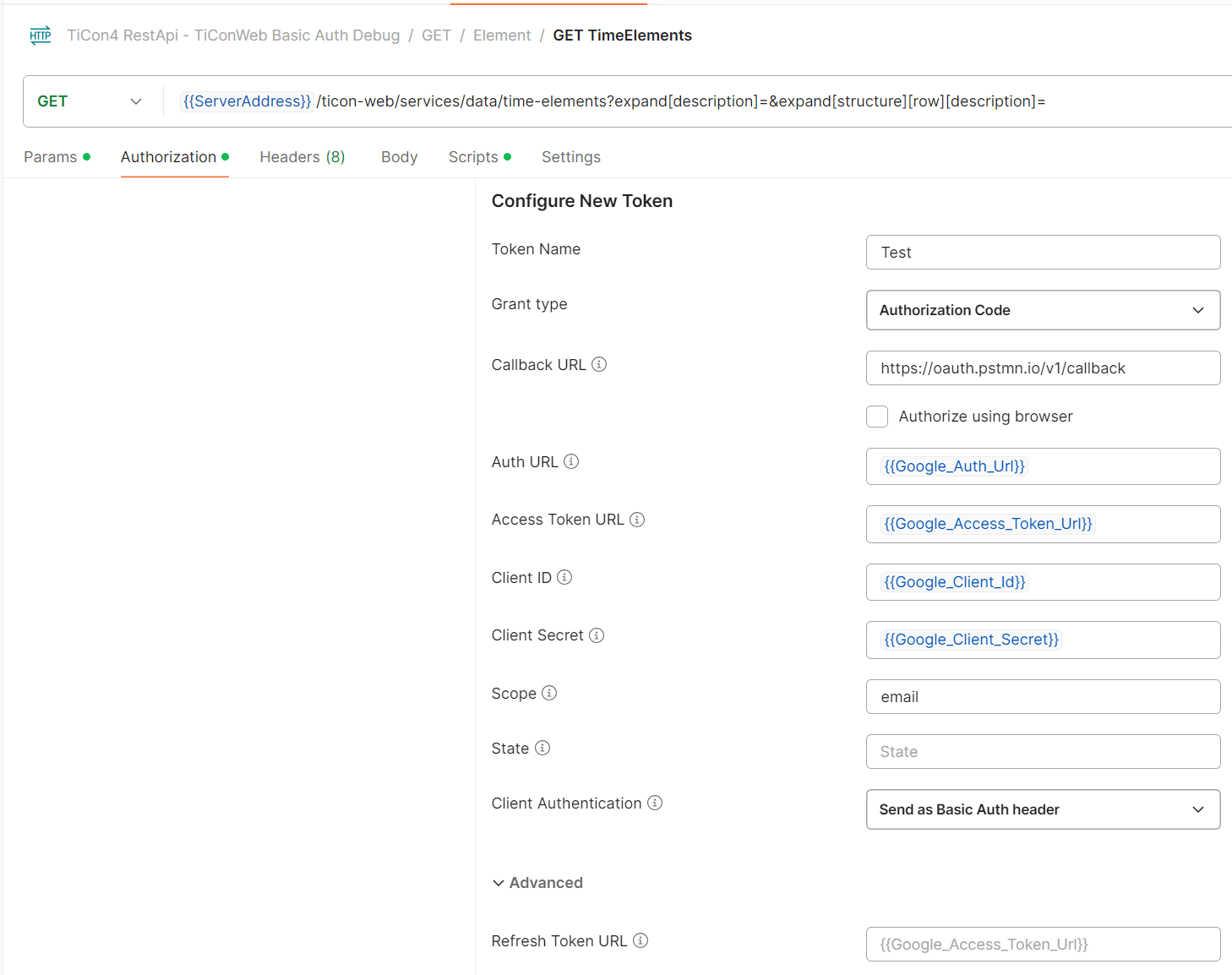
Remarks: When you request a Access Token from the Google Cloud Platform, after your login was successful, in the response from Google you get two tokens, a Access token and a ID token.
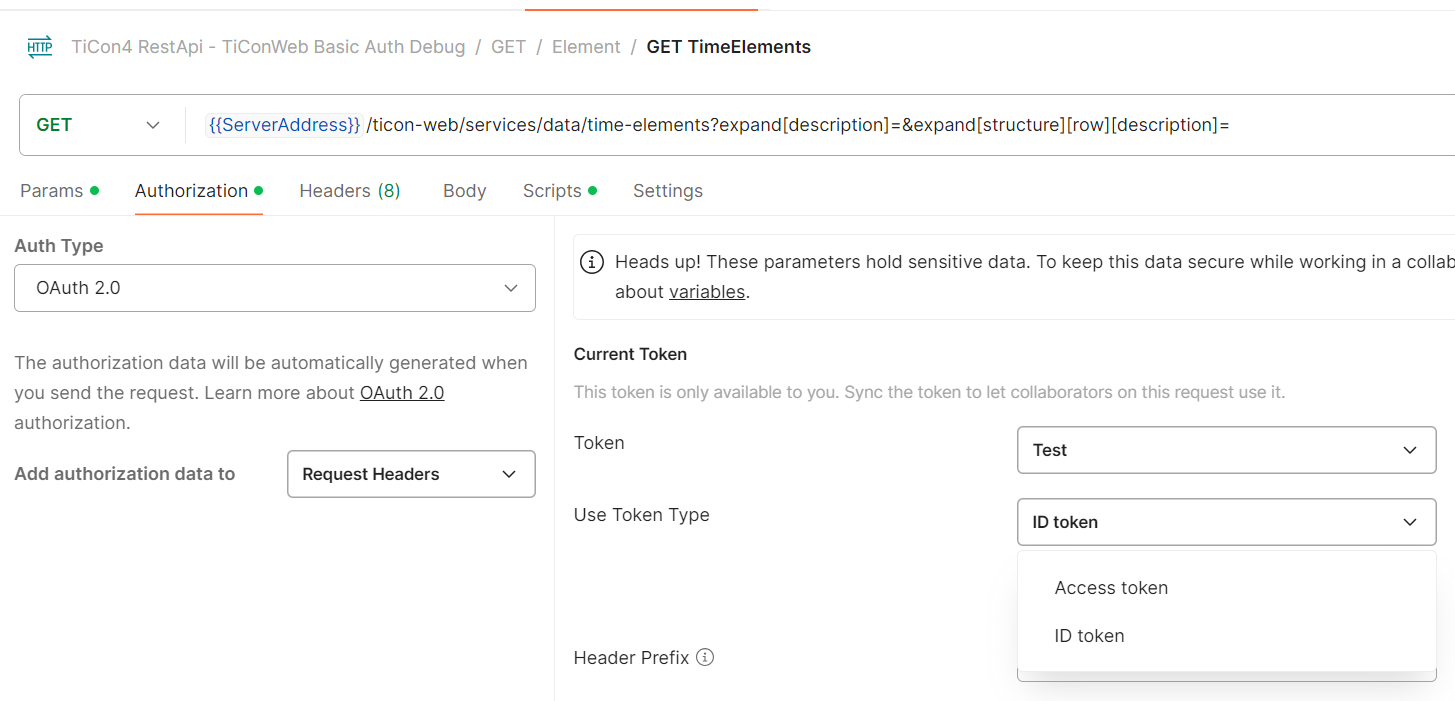
It is a mistake to assume that the Access token would be a authentication token, but this is not the case with the Goolge Cloud Platform, the ID token must be used for authentication, otherwise you will get a authentication exception.
Google does not return a refresh token by default. In order to receive a refresh token on authorization from a Google API, you need to add an extra query parameter to your auth URL. Modify your auth URL to https://accounts.google.com/o/oauth2/v2/auth?access_type=offline, which includes a query parameter of access_type set to offline. The default state is online, and you need to explicitly set it to offline.
Optional: You can send a POST to https://oauth2.googleapis.com/token with the following body:
{
"client_id": "Your Client ID",
"client_secret": "Your Client Secret",
"refresh_token": "Your Refresh Token",
"grant_type": "refresh_token"
}
to refresh the access token.
5.2.3 OAuth users to TiCon4 users mapping
We discussed the OAuth 2.0 configuration in the Azure portal and Google Cloud Platform, and described the configuration in your favorite API development tool. But how can you map the OAuth user to a TiCon4 user, to get access to the database?
In the case of Entra ID, you have to configure TiCon4 to use Microsoft as authentication provider, please take a look into the TiCon4 documentation or ask the TiCon4 support, to reach this goal. In the TiCon4 Admin you can add new users by click the new button User account and select ActiveDirectory user.
![]()
TiCon4 shows only users from your Entra ID and now you can add new users to TiCon4, it saves automatically all necessary data, to get a valid user mapping.
In the case of Google Cloud Platform, your TiCon administrator has to modify the TiCon4 database, he needs a valid Open ID of a Google user and has to change the Provider ID, please contact the TiCon4 support to reach this goal. Another possibility to create a user with a valid Open ID, is to create it by REST API, here is a JSON body example:
[
{
"firstName": "Max",
"lastName": "Mustermann",
"comment": "A user with Google Cloud Platform ID",
"code": "Domainname\\VALIDCODE",
"IsActive": "true",
"MailAddress": "Mailaddress",
"openIdProvider": "Google",
"openId": "Google Open ID"
}
]
and send it by POST to endpoint {{ServerAddress}}/ticon-web/services/data/account. Another option is to add a valid Open ID to an existing external user account via the REST API and change the Open ID provider to Google, here is an example:
[
{
"openIdProvider": "Google",
"sid": null,
"openId": "Google Open ID",
"uid": "{{Account-ID}}"
}
]
Send this Body by PATCH to endpoint {{ServerAddress}}/ticon-web/services/data/account.
After all changes are done, it exists an OAuth to TiCon4 users mapping, and you can use all protected endpoints in the REST API.
6 Entity GET
6.1 structure and behavior
The generic endpoint for reading entities of type Foo has two flavors:
GET /foo/{uid}<L><E>- returns exactly one entity with UIduid, and throws a 4xx error, if the entity could not be loaded. Possible error reasons are:- no entity with the specified UId was found (404)
- UId is present but the entity is not of type
Foo(404) - User does not have access authorization (403)
- Other (400)
GET /foo<F><P><L><E>- returns a list of entities that match the specified filter<F>and are within the specified paging range.- No 4xx errors are returned if one of the specified UIds does not exist or the user does not have access on an element, but the resource is simply not found by the filter.
This behavior is consistent because when called in the first variant, e.g. /time-elements/Element-259, the parameter has the logic of a path to a resource and the path does not exist or is inaccessible.
In the second variant, e.g. /time-elements?uids=Element-259, the path is accessible (/time-elements), and uids=42 has the logic of a search filter. Therefore, no 4xx error should be returned here.
In both variants, the endpoint returns an error if the client-side call was correct, but an error occurred on the server (5xx).
6.2 Filter parameters <F>
Specification of the filter is optional. If no filter is specified, all entities of the respective type will be returned limited only by paging.
The following filter parameter can be used for each entity type:
uids- filter by one or more uids.
Other possible filters depend on the specific entity type.
For time elements, for example, there are the filters code (for the element's code) and user (owner of the element).
If you want to know, how much elements counts the total result, you can add a total counter at the end of JSON result by set counttotalresults=true in your query.
Examples
uids=Element-259,Element-258- Search for items with UIdsElement-259andElement-258code=*AA1*- Search for elements whose code containsAA1code=TEST*&user=mtm- Search for items whose code starts withTESTand is owned by usermtm.description=*time*- Search for elements whose description containtime
6.3 Paging parameter <P>
The page size can be given as a query parameter for each endpoint able to return more than one entity.
top- maximum number of results to return, even if the filter matches more items. Used in combination withskipas the page size for paging.skip- number of elements to be skipped.
When paging is used the items have to be sorted by sortBy parameter.
Examples
top=50- search limited to 50 results, no defined ordertop=50&skip=150&sortBy=uid- skip the first 150 elements, page size is 50 elements and ordered by UID
Remarks
You can configure top in the app settings, you have to set the property MaxTop. When no configuration is found, the default value is 100, the max value is 10000!
6.4 Language parameter <L>
Optional specification of the data language for language texts from the database. If the parameter is not specified or a property is not available in one of the requested languages, the property is returned in its source language.
Examples
lang=de-DE,en-US- Returns texts in German if they are in German, otherwise in English, otherwise in their original data language.lang=fr- Returns texts in French if they are in French, otherwise in their original data language.
6.5 Expand parameter <E>
When data is requested the REST API only returns data stored in primitive data types (like numbers or strings). If you require complex data and multilingual data you have to request it by using property expansion.
A distinction is made between different property types, for which different expansion rules apply:
- Primitive properties are always loaded. This cannot be turned on or off by expansion policy.
- Primitive properties are identified by the type (like string, number, boolean, enumeration, ...)
- Model-Object and Arrays properties are not loaded by default.
- Loaded means: the model object is also transferred in the response object, with direct JSON inlining at the property.
- Not loaded means: the property is completely omitted and not contained in the JSON.
- Model-Object properties can be expanded in the schema view from the OpenAPI documentation. They can be distinguished from _Entity_s by the lack of a UID.
- Language Text properties are not loaded by default. Loading must be explicitly specified in the expansion policy for the property in question.
- Loaded means: the text including meta data is also transferred in the response object, with direct JSON inlining at the property.
- Not loaded means: the property is set to null.
- That are complex types composed by a language, text and isSource property.
- Entity properties are not loaded by default. Loading must be explicitly specified in the expansion policy for the property in question.
- Loaded means: the model object is also transferred in the response object, but there is no direct JSON inlining on the property. Instead, the entity's UID is passed as the property value, and the entity itself is appended to a list (
expanded) in the response object. It is handled in this way because an entity - in contrast to model objects - can be referenced several times in the response. Thus this approach saves bandwidth. Furthermore, there is no guarantee that entity graphs are free from cycles. - Not loaded means: the UID of the referenced entity is specified as the value for the property (not
nullas with model objects), but the entity is not appended toexpandedin the response object. - These properties end with Uid or Uids
- Loaded means: the model object is also transferred in the response object, but there is no direct JSON inlining on the property. Instead, the entity's UID is passed as the property value, and the entity itself is appended to a list (
From the OpenAPI documentation it is easy to determine which properties need expansion to retrieve their values, because every time you can expand a property in the schema view it also needs expansion for data retrieval (except for enums, which can be expanded in the documentation's schema view, but are always loaded as they are primitive data types).
Examples
expand[description]
The above expansion query parameter will retrieve the description of an entity. The description is a Language Text property and as such not expanded by default. You'll find the value directly in the JSON, like this
{
"description": {
"language": "en-US",
"text": "Walk / m",
"isSource": true
}
}
expand[folder]
The above expansion query parameter will retrieve the folder entity. The expanded folder object can be found in the expanded section by searching for the uid. The expanded object cannot be found directly in the property because a folder is a separate entity.
{
"entities": [
{
"folderUid": "Folder-20"
}
],
"expanded": [
{
"code": "MTM-UAS-BASE",
"objectType": "Folder",
"uid": "Folder-20"
}
]
}
expand[folder][description] - A property expansion can be nested as in the preceding example where the description of folder entities is expanded. This will implicitly expand the folder as well.
expand[description] - load the description of an element (directly in the entity as the description is a model property)
expand[structure][row][element][description] - load the used structure element in the expand section as the used element is a separate entity. The used element's description will also be loaded and can be found in the used element itself.
expand[workorganization] - loads the workorganization properties of the element.
{
"workorganization": {
"grossShiftDuration": 850000,
"netShiftDuration": 800000,
"taktDuration": 0,
"piecesPerShift": 0,
"performance": null,
"totalAllowance": null,
"availableTgPerShift": 800000,
"additionalTimePersonal": null,
"additionalTimeObjective": null,
"nonRepetitiveDifferenceDuration": 800000,
"nonRepetitiveDuration": 0,
"inputModeType": "NetWorkingTimeAndTaktTime",
"workplaceSizeType": "SmallWorkplace",
"bodyPercentile": 50,
"genderType": "None"
}
}
expand[timetgbycriterionuid] - loads the time TG by criterion structure of the element.
{
"timeTgByCriterionUid": [
{
"key": "IndicatorCriterion-3",
"value": 0
},
{
"key": "IndicatorCriterion-10001",
"value": 0
},
{
"key": "IndicatorCriterion-10004",
"value": 0
},
{
"key": "IndicatorCriterion-1",
"value": 0
},
{
"key": "IndicatorCriterion-10000",
"value": 0
},
{
"key": "IndicatorCriterion-10005",
"value": 0
},
{
"key": "IndicatorCriterion-10002",
"value": 0
},
{
"key": "IndicatorCriterion-2",
"value": 0
},
{
"key": "IndicatorCriterion-10003",
"value": 0
}
]
}
expand[workorganizationBreakStructure][row][description] - loads the used workorganization break structure element in the expand section as the used element is as separate entity.
{
"workorganizationBreakStructure": [
{
"identifier": "766",
"row": {
"duration": 50000,
"description": {
"language": "de-DE",
"text": "Mittagspause",
"isSource": true
}
}
},
{
"identifier": "767",
"row": {
"duration": 50000,
"description": {
"language": "de-DE",
"text": "Erholpause",
"isSource": true
}
}
}
]
}
expand[structure][row][times] - loads the times of the used time element, user specific times [T01 ... T12] or the sum of all times in section for all rows.
{
"row": {
"times": {
"ttu": 27.777777777777775,
"tg": 27.777777777777775,
"te": 27.777777777777775,
"t01": 100.0,
"t02": 10.0,
"t03": 675.0,
"t04": 90.0,
"t06": 67.0,
"t08": 890.0
}
}
}
expand[structure][row][totalTimes] - loads the times with mulitplicated factor (all factors inclusive additional factor).
{
"row": {
"totalTimes": {
"tg": 69.44444444444444,
"te": 69.44444444444444
}
}
}
6.5.1 NULL value handling
The default NULL value handling is, that properties, without a valid number, enum or string, are not available in JSON result. The reason is for this behavior is, to make the HTTP stream smaller, especially with very complex classes, such as the time vector or a very complex structure.
Is zero printed or not?
In all TiCon classes, zero values are displayed in JSON structure, because in the most cases, they are relavant informations. An exception is the time vector class. They is very complex and has a large number of properties, that can become confusing very quickly. For this reason, all times that are zero are not displayed in JSON result, only times that are not zero.
At the moment there is a special exception regarding the NULL value handling. This is the query of folders, if there is no parent directory, an empty string is displayed in the JSON result. This should be changed in the future and adapted to the standard NULL value handling.
6.6 Examples
6.6.1 Time Elements
Here you will find some examples for getting time elements by using the endpoint
{{ServerAddress}}/ticon-web/services/data/time-elements
Basic parameters
- code filters elements by a certain CODE parameter.
- uids filters elements by UIDs, separated by comma.
- codewildcards true to use wildcards in element search
- top the maximum number of shown elements. The default value is 20 and the max number of elements is limited to 100!
- expand true to get details about complex navigation properties, like a structure, row. If a property can be extended via expand, it can be seen from the UID extension in the property name, see elementStatusUid or analyzeMethodUid at the return example below. All expanded properties can be found in the expanded clause at the end of the JSON string.
Returns
A list of all elements from all folders except the DataCard folder, where the current user has the minimum permission read.
{
"entities": [
{
"shortCode": "AHG02",
"analyzeMethodUid": "AnalyzeMethod-3",
"times": {
"ttbUser": 16,
"tg": 16,
"te": 16,
"t": 16
},
"defaultCriterionUids": [
{
"key": "0",
"value": "IndicatorCriterion-1"
},
{
"key": "1",
"value": "IndicatorCriterion-2"
},
{
"key": "2",
"value": "IndicatorCriterion-3"
}
],
"timeTgByCriterionUid": [
{
"key": "IndicatorCriterion-2",
"value": 0
},
{
"key": "IndicatorCriterion-3",
"value": 0
},
{
"key": "IndicatorCriterion-10001",
"value": 0
},
{
"key": "IndicatorCriterion-10004",
"value": 0
},
{
"key": "IndicatorCriterion-10002",
"value": 0
},
{
"key": "IndicatorCriterion-1",
"value": 0
},
{
"key": "IndicatorCriterion-10003",
"value": 0
},
{
"key": "IndicatorCriterion-10005",
"value": 0
},
{
"key": "IndicatorCriterion-10000",
"value": 0
}
],
"createTime": "1983-08-28T00:00:00",
"modifyTime": "1997-10-28T00:00:00",
"ownerUid": "Account-2",
"modifyUserUid": "Account-2",
"elementStatusUid": "ElementStatus-7",
"elementTypeUid": "ElementType-1",
"elementConfigurationUid": "ElementClassConfiguration-4104",
"folderUid": "Folder-19",
"code": "2000AHG02..4",
"objectType": "TimeElement",
"uid": "Element-10"
}
],
"expanded": [
{
"categoryUid": "IndicatorCategory-2",
"color": "FFFFFF",
"code": "NONE",
"objectType": "ProcessIndicatorCriterion",
"uid": "IndicatorCriterion-2"
},
{
"categoryUid": "IndicatorCategory-3",
"color": "FFFFFF",
"code": "NONE",
"objectType": "ProcessIndicatorCriterion",
"uid": "IndicatorCriterion-3"
},
{
"categoryUid": "IndicatorCategory-1",
"color": "FFFFFF",
"code": "NONE",
"objectType": "ProcessIndicatorCriterion",
"uid": "IndicatorCriterion-1"
}
]
}
Examples
The following examples demonstrate how to find time elements by code or UIDs, how to use wild card search and expand structure and description.
{{ServerAddress}}/ticon-web/services/data/time-elements?code=3000AA1....5
{{ServerAddress}}/ticon-web/services/data/time-elements?uids={{uid}},{{uid}}
{{ServerAddress}}/ticon-web/services/data/time-elements?code=AN*&codewildcards=true
{{ServerAddress}}/ticon-web/services/data/time-elements?code=AN*&codewildcards=true&top=5
{{ServerAddress}}/ticon-web/services/data/time-elements/Element-13?expand[defaultcriterion]=true&counttotalresults=true
{{ServerAddress}}/ticon-web/services/data/time-elements?code=AN*&codewildcards=true&expand[description]&expand[structure][row][element][description][elementconfiguration]&expand[times]
{{ServerAddress}}/ticon-web/services/data/time-elements?code=B.13744&expand[description]&expand[structure][row][element][description]&expand[structure][row][criterion][description]&expand[defaultcriterion][description]
{{ServerAddress}}/ticon-web/services/data/time-elements?expand[structure][row][criterion][description]&expand[structure][row][element][times]&expand[timetgbycriterionuid]&expand[times]&code=An.1...4&expand[structure][row][singletime]&expand[structure][row][totalTime]&expand[workOrganization]&expand[times]
{{ServerAddress}}/ticon-web/services/data/time-elements?expand[description]=&expand[criteria][row]&expand[criteria][row][fixedCriterionValue][description]&expand[criteria][row][elementCriterion][description]
Here is another example, how to get formula values in a time element.
{{ServerAddress}}/ticon-web/services/data/time-elements?expand[structure][row]&code=xxxx&expand[structure][row][description]&expand[structure][row][element]&expand[structure][row][formulavalues][row]
As you can see, it's always the same principle, when you want to get extended properties, expand it! Please take a look here.
Remarks
All text properties, as description, begin, end and can also be expanded, but the properties are displayed directly on the property in the JSON string and not in the expanded node, as described above. Other exceptions are: structure, element, row depending on which element type is queried.
6.6.2 Stream Elements
{{ServerAddress}}/ticon-web/services/data/stream-elements?expand[structure]
The most import property is the structure property, that is constructed as follows:
- Contains an entry for each
- variant (typeEnum = Stream2Variant)
- station (typeEnum = Stream2Station)
- worker/machine (typeEnum = Stream2Resource)
- allocation to a worker (typeEnum = Stream2Allocation)
- other data, such as content from the work content and more
- There is always at least one line of type Stream2Variant
- Structure is tree-like, the parent-child relationships can be interfered from the order (sorted by order number)
- Variants have no parent
- The station's parent is the variant with the largest ordinal number that is smaller than that of the station
- The parent of a worker/machine is the station with the largest ordinal number that is smaller than that of the worker/machine
- The parent of an allocation is the worker/machine with the largest ordinal number that is smaller than that of the allocation
Examples
{{ServerAddress}}/ticon-web/services/data/stream-elements
{{ServerAddress}}/ticon-web/services/data/stream-elements?code=T861600&expand[owner]&expand[elementConfiguration][description]&expand[folder][description]&expand[folder][parentFolder][description]
{{ServerAddress}}/ticon-web/services/data/stream-elements?code=T861600&expand[description]&expand[elementType][description]&expand[elementStatus][description]&expand[structure][row][description]
{{ServerAddress}}/ticon-web/services/data/stream-elements?code=T861600&expand[description]&expand[elementType][description]&expand[workorganizationBreakStructure][row][description]
{{ServerAddress}}/ticon-web/services/data/stream-elements?expand[description]&expand[workorganizationBreakStructure][row][description]&expand[workorganization]
6.6.2.1 Stream Elements times
The time section is a very important value of the structure property in Stream elements. It exists the following time properties:
entity.structure[].row.timesentity.structure[].row.ergoTimes
Examples
{{ServerAddress}}/ticon-web/services/data/stream-elements?expand[structure][row][description]&code=TZ733MH...Ü5&expand[description]&expand[structure][row][ergotimes]&expand[structure][row][criterionuids]
{{ServerAddress}}/ticon-web/services/data/stream-elements?expand[structure][row][description]&code=TZ733MH...Ü5&expand[structure][row][times]&expand[description]
{{ServerAddress}}/ticon-web/services/data/stream-elements?expand[workorganization]&expand[structure][row][description]&expand[structure][row][times]&expand[description]&folderuids=Folder-56
Remarks
The times property loads the times of the used time element or user specific times [T01 ... T12] for all rows.
6.6.3 Folders
{{ServerAddress}}/ticon-web/services/data/folders
Returns a list of all folders, where the current user has the minimum permission read.
Examples
{{ServerAddress}}/ticon-web/services/data/folders?code=MTM&expand[description]&expand[parentFolder]
{{ServerAddress}}/ticon-web/services/data/folders?uids=Folder-1,Folder-10
{{ServerAddress}}/ticon-web/services/data/folders?code=MT*&codeWildcards=true
{{ServerAddress}}/ticon-web/services/data/folders?expand[description]&expand[parentfolder][description]&description=*prozessbau*&descriptionWildcards=true
To create a folder send a POST request to
{{ServerAddress}}/ticon-web/services/data/folders
with a body
[
{
"code": "NEU",
"description": {
"language": "de-DE",
"text": "Neuer Ordner"
},
"type": "System",
"parentFolderUid": "Folder-164"
}
]
To delete a folder send a DELETE request to
{{ServerAddress}}/ticon-web/services/data/folders/Folder-175
6.6.4 Element configurations
{{ServerAddress}}/ticon-web/services/data/element-configurations
To get all Element configurations from REST, where the current user has the minimum permission read.
Examples
{{ServerAddress}}/ticon-web/services/data/element-configurations?expand[description]
{{ServerAddress}}/ticon-web/services/data/element-configurations?uids={{uid}},{{uid}}
{{ServerAddress}}/ticon-web/services/data/element-configurations?expand[description]&description=*time*&descriptionWildcards=true
6.6.5 Element types
{{ServerAddress}}/ticon-web/services/data/element-types
Get all Element types from REST.
Examples
{{ServerAddress}}/ticon-web/services/data/element-types?expand[description]
{{ServerAddress}}/ticon-web/services/data/element-types?uids={{uid}}
6.6.6 Element statuses
{{ServerAddress}}/ticon-web/services/data/element-statuses
Get all Element status from REST.
Examples
{{ServerAddress}}/ticon-web/services/data/element-statuses?expand[description]
{{ServerAddress}}/ticon-web/services/data/element-statuses?uids={{uid}},{{uid}}
6.6.7 Indicator criterions
{{ServerAddress}}/ticon-web/services/data/process-indicators
Get all available indicator criterions from REST.
Examples
{{ServerAddress}}/ticon-web/services/data/process-indicators?expand[description]
{{ServerAddress}}/ticon-web/services/data/process-indicators?uids={{uid}},{{uid}}
6.6.8 Formula elements
{{ServerAddress}}/ticon-web/services/data/formula-elements
Get all Formula elements from REST.
Examples
{{ServerAddress}}/ticon-web/services/data/formula-elements?expand[description]&code=A..ZBAHS.TE5
{{ServerAddress}}/ticon-web/services/data/formula-elements?expand[description]&uids={{uid}},{{uid}}
{{ServerAddress}}/ticon-web/services/data/formula-elements?expand[description]&expand[structure][row][description]
{{ServerAddress}}/ticon-web/services/data/formula-elements?expand[formulacriterion][description]&expand[description]&expand[structure][row][description]&expand[structure][row][variableValues]
{{ServerAddress}}/ticon-web/services/data/formula-elements?expand[content]&expand[description]&index=idx&expand[longText1]&expand[images][row][element][binary]
{{ServerAddress}}/ticon-web/services/data/formula-elements?expand[content]&expand[description]&index=idx&expand[journal][row][journalDetails][row]
{{ServerAddress}}/ticon-web/services/data/formula-elements?expand[content]&expand[formulacriterion]&expand[structure][row][element]&expand[description]&expand[structure][row][description]&index=idx&expand[structure][row][variableValues][row][description]
6.6.9 Station elements
{{ServerAddress}}/ticon-web/services/data/resource-station-elements
Get all Station elements from REST.
| No. | Content | Property Name and Remarks |
|---|---|---|
| 1 | Color | entity.color |
Examples
{{ServerAddress}}/ticon-web/services/data/resource-station-elements?expand[description]&code=STATION
{{ServerAddress}}/ticon-web/services/data/resource-station-elements?expand[description]&uids={{uid}},{{uid}}
{{ServerAddress}}/ticon-web/services/data/resource-station-elements?expand[description]&expand[machinesOrOperators][row][description]
{{ServerAddress}}/ticon-web/services/data/resource-station-elements?expand[description]&expand[machinesOrOperators][row][description]&expand[carriers][row][description]&expand[tools][row][description]
6.6.10 Operator elements
{{ServerAddress}}/ticon-web/services/data/resource-operator-elements
Get all Operator elements from REST.
| No. | Content | Property Name and Remarks |
|---|---|---|
| 1 | Color | entity.color |
Examples
{{ServerAddress}}/ticon-web/services/data/resource-operator-elements?expand[description]&code=OPERATOR
{{ServerAddress}}/ticon-web/services/data/resource-operator-elements?expand[description]&uids={{uid}},{{uid}}
{{ServerAddress}}/ticon-web/services/data/resource-operator-elements?expand[description]&expand[qualifications][row][description]
6.6.11 Machine elements
{{ServerAddress}}/ticon-web/services/data/resource-machine-elements
Get all Machine elements from REST.
| No. | Content | Property Name and Remarks |
|---|---|---|
| 1 | Color | entity.color |
Examples
{{ServerAddress}}/ticon-web/services/data/resource-machine-elements?expand[description]&code=MACHINE
{{ServerAddress}}/ticon-web/services/data/resource-machine-elements?expand[description]&uids={{uid}},{{uid}}
{{ServerAddress}}/ticon-web/services/data/resource-machine-elements?expand[description]&expand[qualifications][row][description]
{{ServerAddress}}/ticon-web/services/data/resource-machine-elements?expand[description]&expand[qualifications][row][description]&expand[tools][row][description]
6.6.12 Carrier elements
{{ServerAddress}}/ticon-web/services/data/resource-carrier-elements
Get all Carrier elements from REST.
| No. | Content | Property Name and Remarks |
|---|---|---|
| 1 | Color | entity.color |
Examples
{{ServerAddress}}/ticon-web/services/data/resource-carrier-elements?expand[description]&code=CARRIER
{{ServerAddress}}/ticon-web/services/data/resource-carrier-elements?expand[description]&uids={{uid}},{{uid}}
6.6.13 Qualification elements
{{ServerAddress}}/ticon-web/services/data/resource-qualification-elements
Get all Qualification elements from REST.
| No. | Content | Property Name and Remarks |
|---|---|---|
| 1 | Color | entity.color |
Examples
{{ServerAddress}}/ticon-web/services/data/resource-qualification-elements?expand[description]&code=QUALIFICATION
{{ServerAddress}}/ticon-web/services/data/resource-qualification-elements?expand[description]&uids={{uid}},{{uid}}
6.6.14 Tool elements
{{ServerAddress}}/ticon-web/services/data/resource-tool-elements
Get all Tool elements from REST.
| No. | Content | Property Name and Remarks |
|---|---|---|
| 1 | Color | entity.color |
Examples
{{ServerAddress}}/ticon-web/services/data/resource-tool-elements?expand[description]&code=TOOL
{{ServerAddress}}/ticon-web/services/data/resource-tool-elements?expand[description]&uids={{uid}},{{uid}}
6.6.15 Material elements
{{ServerAddress}}/ticon-web/services/data/product-material-elements
Get all Material elements from REST.
| No. | Content | Property Name and Remarks |
|---|---|---|
| 1 | Unit | entity.unit |
| 2 | Color | entity.color |
| 3 | Quantity | entity.quantity |
Examples
{{ServerAddress}}/ticon-web/services/data/product-material-elements?expand[description]&code=MATERIAL
{{ServerAddress}}/ticon-web/services/data/product-material-elements?expand[description]&uids={{uid}},{{uid}}
6.6.16 ConsumableSupplies elements
{{ServerAddress}}/ticon-web/services/data/product-consumable-supplies-elements
Get all ConsumableSupplies elements from REST.
| No. | Content | Property Name and Remarks |
|---|---|---|
| 1 | Unit | entity.unit |
| 2 | Color | entity.color |
| 3 | Quantity | entity.quantity |
Examples
{{ServerAddress}}/ticon-web/services/data/product-consumable-supplies-elements?expand[description]&code=CONSUMABLESUPPLIES
{{ServerAddress}}/ticon-web/services/data/product-consumable-supplies-elements?expand[description]&uids={{uid}},{{uid}}
6.6.17 WorkPiece elements
{{ServerAddress}}/ticon-web/services/data/product-work-piece-elements
Get all WorkPiece elements from REST.
| No. | Content | Property Name and Remarks |
|---|---|---|
| 1 | Unit | entity.unit |
| 2 | Color | entity.color |
| 3 | Quantity | entity.quantity |
Examples
{{ServerAddress}}/ticon-web/services/data/product-work-piece-elements?expand[description]&code=WORKPIECE
{{ServerAddress}}/ticon-web/services/data/product-work-piece-elements?expand[description]&uids={{uid}},{{uid}}
{{ServerAddress}}/ticon-web/services/data/product-work-piece-elements?expand[description]&expand[bomUnitList][row][description]
6.6.18 Document elements
{{ServerAddress}}/ticon-web/services/data/document-elements
Get all Document elements from REST.
| No. | Content | Property Name and Remarks |
|---|---|---|
| 1 | Source of binary data | entity.sourceType (either Database, Filesystem or Url) |
| 2 | Filesystem path | entity.path (if stored in Filesystem) |
| 3 | Time of creation of document data | entity.creationTimestamp |
| 4 | Size of document data | entity.size |
| 5 | Language of document | entity.language (see 6.4.) |
Examples
{{ServerAddress}}/ticon-web/services/data/document-elements?expand[description]&code=DOCUMENT
{{ServerAddress}}/ticon-web/services/data/document-elements?expand[description]&uids={{uid}},{{uid}}
6.6.18.1 Document element binary data
If the document is stored inside the database (entity.SourceType equals Database) binary data can be extracted by expanding the binary section.
Examples
{{ServerAddress}}/ticon-web/services/data/document-elements?expand[description]&expand[binary]
6.6.19 AccountRoles
{{ServerAddress}}/ticon-web/services/data/accountRoles
Get all Roles from REST.
| No. | Content | Property Name and Remarks |
|---|---|---|
| 1 | Category 1 | entity.category1 |
| 2 | Category 2 | entity.category2 |
| 3 | Category 3 | entity.category3 |
| 4 | Accounts | entity.accountRoles |
| 5 | Functions | entity.roleAdminObjects |
Examples
{{ServerAddress}}/ticon-web/services/data/accountRoles?expand[description]&expand[category1]&expand[accountroles][account]
{{ServerAddress}}/ticon-web/services/data/accountRoles?expand[description]&expand[category1]&expand[accountroles]&expand[roleAdminObjects]
7 Entity Delete
To delete elements, you have to send the request as DELETE method.
{{ServerAddress}}/ticon-web/services/data/time-elements?uids=
Deletes elements by UIDs, when the current user has the minimum permission write.
Examples
{{ServerAddress}}/ticon-web/services/data/time-elements?uids={{uid}}
{{ServerAddress}}/ticon-web/services/data/time-elements?uids={{udi}},{{uid}}
Remarks
The Microsoft IIS server don't allow the delete method by default. Don't forgive to enable this feature in your side settings, bevore use the delete possibility of the REST API.
8 Entity Duplicate
To duplicate elements, you have to create duplicate information as JSON in the request body and send it as POST to the server.
{{ServerAddress}}/ticon-web/services/data/duplicate
Examples
{
"isDuplicateChildren": true,
"isRemoveDocumentElements": false,
"isRemoveAssignmentElements": false,
"isRemoveCycleInformation": false,
"isResetTexts": false,
"elements": [
{
"uid": "Element-14172",
"newCode": "P1-X",
"newIndex": "I1",
"newVariant": "V1",
"newFolderUid": "Folder-136"
},
{
"uid": "Element-14173",
"newCode": "P2-X",
"isChild": true
}
]
}